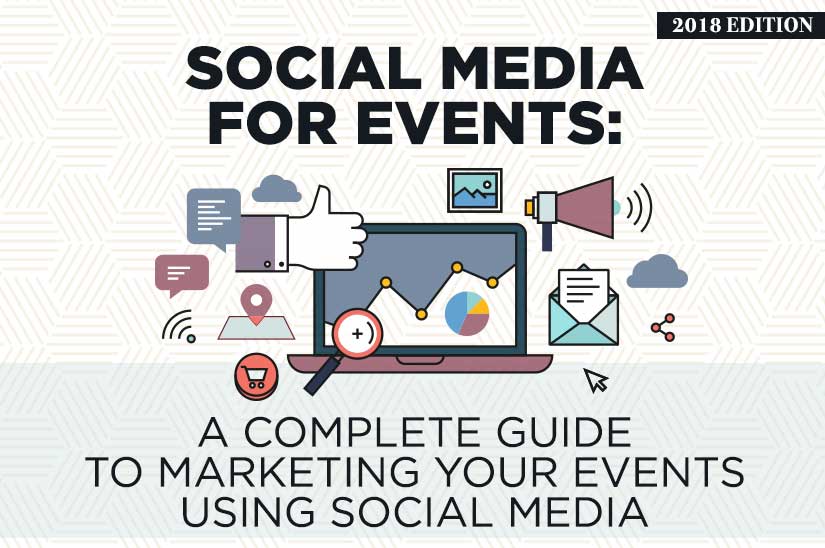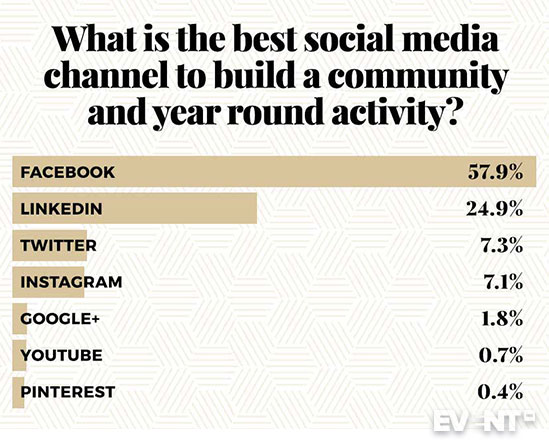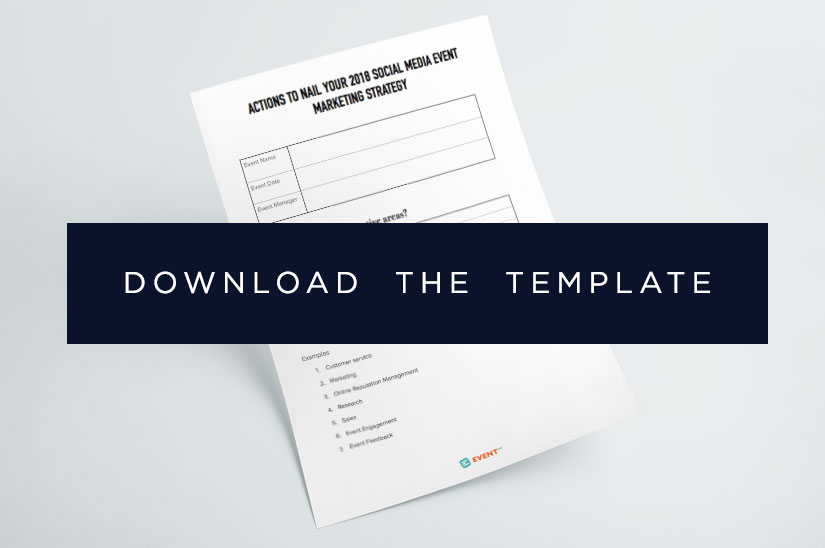
42 strategies, ideas, tips and tactics to use social media to promote events. The intelligence you need to make better decisions in one handy guide.
Social media is awesome right? Yet it can be overwhelming and resource intensive.
Knowing how to use social media at live events correctly is not an innate gift. It can be learned and this is what this guide is for. It is your gateway to have a comprehensive framework to promote events using social media.
- Social media event marketing strategy, backed by research.
- How To Convince Your Boss to spend event marketing dollars on social media
- Your Essential Social Media Policy
- 6 Actions to Nail Your Social Media Event Marketing Strategy
- A free pdf with a social media template
- How to choose the Right Social Media to Successfully Promote Your Events
- A Complete Guide to Promoting Your Event Hashtag
- 19+ Pre Event Hype Ideas For Social Media
- A 4 Step Action Plan to Working with Social Media Influencers
- Be a Master of FOMO With Pre-event Social Media Contests
- After Your Event: 8 Ideas to Continue the Social Media High
- 4 Steps To Keep Your Cool and Navigate an Event Social Media Crisis
- 10 Trends redefining social media for events
Social Media Event Marketing Strategy – Backed by Research
Lots of chit chat around social media for events. What about using research to support your decisions?
It so happens we have carried the largest research to date on the topic.
We will share it with you in a second.
But why should you care about promoting your event using social media?
Simple answer.
Social signals are among the most important factors in online marketing. Especially for complex decision-making processes, such as ticket purchasing or registration.
Every action, update, post, presentation, picture or video that you upload to social media will have an impact on your online marketing efforts. When a prospective attendee is evaluating whether to purchase a ticket to your event, they will inevitably stumble on what you presented on social media.
This process has a terrific impact on how event websites rank for specific keywords on Google. If in fact, content is social media’s currency, using it wisely will have substantial search engine optimization implications. The more you concentrate on creating value via relevant and focused content, the better your event website will perform on Google. Likewise, signals from social media, including lots of impressions, sharing and click-throughs can have a direct impact on your search engine rankings.
This is why marketing is by far the most used application of social media according to our research:

Event planners specified that social media is used most commonly for pre-event engagement, by 89%
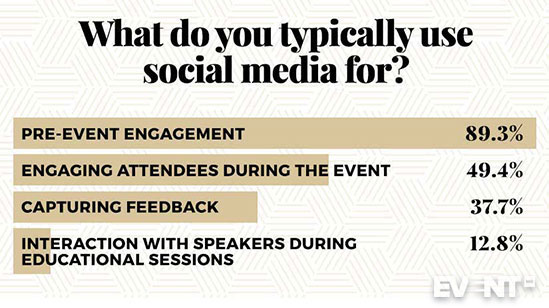
Facebook is the Most Popular Social Media Channel for Event Planners
Our research tells us that these are the channels event professionals are active on:
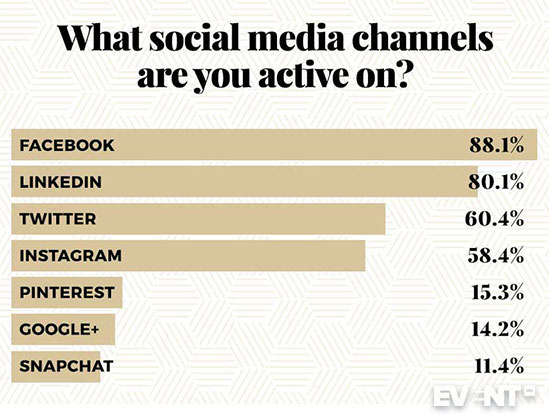
Event Planners Agree that Facebook is Most Effective for Event Promotion
52% of event planners specified that Facebook is the most effective social media channel for event promotion.
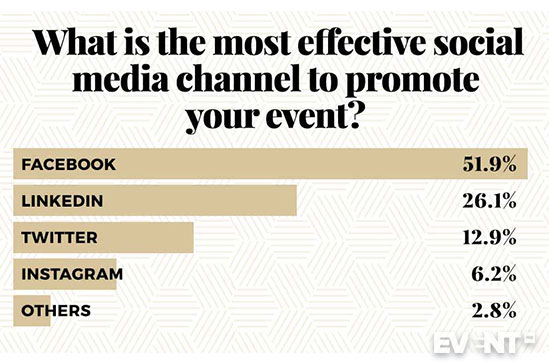
31% rate social media campaigns as very important and 53% as important.
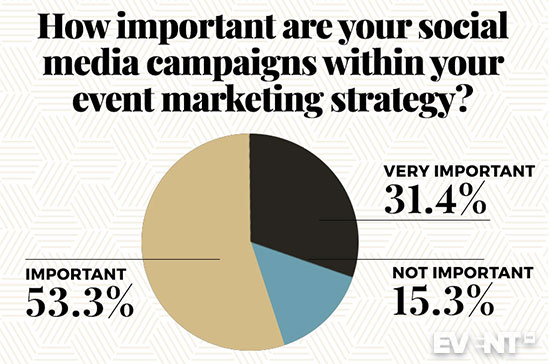
Facebook is Effective for Managing Customers
Facebook also scores well in terms of managing customers and again comes out on top.
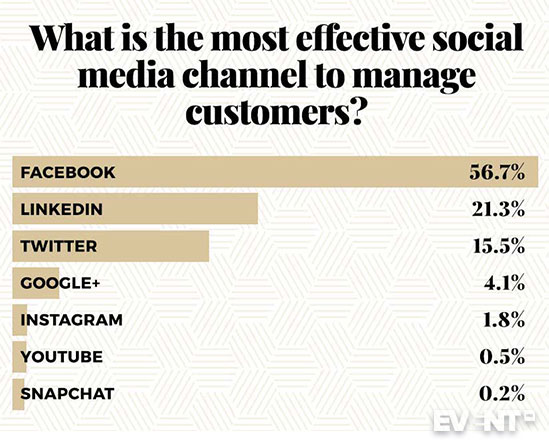
Facebook is Preferred as a Community Building Tool
Facebook also came out top as a community building tool, with LinkedIn and Twitter in second and third place respectively.
Some Event Planners are Allocating a Sizeable Budget to Social Media
The next question should be how much money should you spend on social media. There is no universal answer, but our research tells us that these are the average brackets of expenditure:
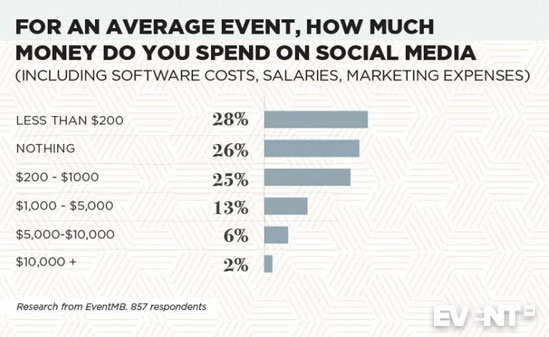
Almost Half of All Events Have a Dedicated Social Media Team
Research also tells us that event planners have dedicated teams. That doesn’t mean you should ignore its dynamics. Many times brands have been in PR blunders because nobody was there to control what was going on:
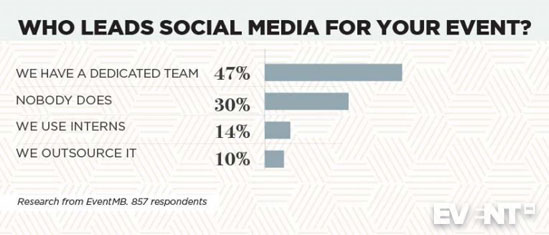
Little and Often: The Formula for Social Media Engagement
How often should you use social media to promote your event? This is pretty much similar to asking how often should you post a blog post or send a newsletter. We have some tips for you in the trends section, so keep reading, but this is how the industry stacks up:
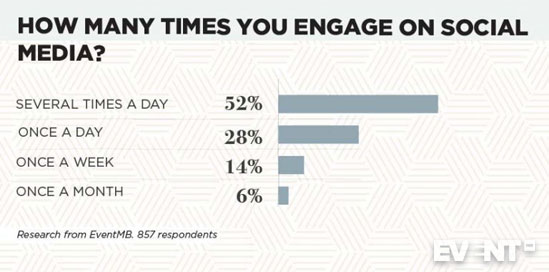
Half of Event Planners Use Social Media Advertising
50% of event planners use social media ads for their events. 3% of survey respondents were unsure.
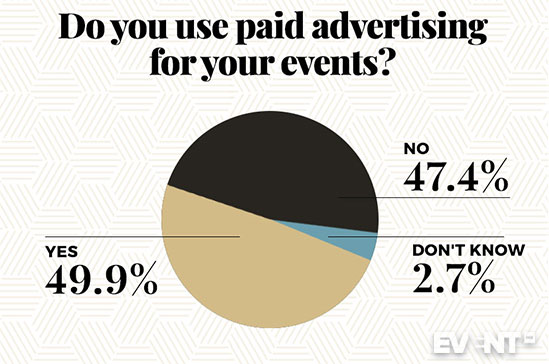
If you would like a copy of this research for publishing you can request it here: State of the Event Industry Research.
How To Convince Your Boss to Spend Event Marketing Dollars on Social Media
There are still a number of myths and shallow skepticism when it comes to social media. This is for several reasons:
- Compared to some forms of marketing, social media is a relatively new way of doing marketing, sales, PR and customer service.
- In the early days, self-proclaimed social media mavens took advantage of the buzz and brought disastrous campaigns to undiscerning clients.
- It can be overwhelming. There is a lot going on on social media, you need to learn a new language, deal directly with criticism and negativity, keep track of messages and updates on several platforms.
While all of the above are valid reasons to think of your social media project as a complex process, it does not justify most of the criticism and skepticism out there. We will address the most recurring criticism, myths and arguments so that you are ready to respond to the concerns of your boss, even if the boss is yourself.
-
Social Media is a Fad
This was a common opinion back in 2008/2009 when Facebook and Twitter were booming. Most bosses were very quick to dismiss social media as the fashion of the moment. Something that in a couple of years was going to be dissolved.
It is tough to have such an opinion today. If you look around, you will notice your peers, friends, colleagues, parents, children, relatives, equally involved in using some form of social media. Whether it is Facebook, a blog, Instagram, a LinkedIn profile or Snapchat, it seems that everybody is involved on some level with social media.
This does not translate into an immediate reason why you should engage with social media, but the numbers are unprecedented. What we are witnessing is not comparable to anything we’ve seen before. It is a way of life.
-
Attendees Will Say Negative Things About Us
This is at the same time the easiest and most difficult concern to tackle. It does not take a clinical psychologist to understand that if you are worried about negativity coming your way, you are either not confident in your event or are trying to hide wrongdoings.
This is not a myth. It is a reality. If your event sucks attendees will say it out loud on social media. At the same time, if your event is great attendees will equally say it on social (maybe in smaller numbers, as we don’t like to compliment as much as complain). But, here is a twist, attendees may be already saying something negative about your event, without you realizing or doing anything about it.
The last bit scares the hell out of most people. If you have any negativity heading your way, it is very desirable to be aware and address it on social networks.
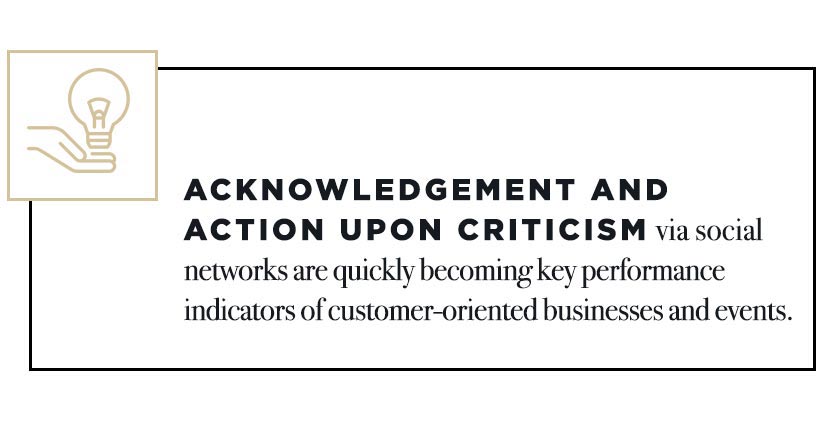
Acknowledgement and action upon criticism via social networks are quickly becoming key performance indicators of customer-oriented businesses and events. The attitude towards negativity should be to investigate further and fix criticism, rather than deny it.
-
Our Customers are Not on Social Media
While the stats about social networks make it almost impossible for your prospective customers not to be on social, there is a case to determine whether it is right for your audience. While most are on social, they are not necessarily willing to engage on social to buy an event ticket or research their attendance at a particular conference.
The correct approach to this criticism is to respond with numbers. Analysis of competitors, attendee research and an event registration form that asks for social network handles will give you the data you need. If the numbers are strong enough there will be no case against your proposed program.
On the other hand, if you don’t have the numbers and the opportunity is weak, you are chasing something that may be irrelevant to your audience. Or at least not important enough (yet) to dedicate resources to it.
-
Social Media is for Large Brands, Not for Events
While large brands are obviously very engaged with social media, there is a growing literature of case studies supporting the use of social media by businesses small and large, in B2B environments and for events, regardless of their size. It is usual to have several event-specific social media channels and this is naturally what your attendees will be searching for.
-
Social Media is Cheap
One of the reasons why bosses actually decide to use social media is the assumption it is cheap. As much as this could seem like a positive feature, it will actually turn out to be a recipe for disaster.
Yes, setting up a Youtube account and posting videos costs nothing in comparison to the cost of advertising on TV or print expenditure 25 years ago. However, the fact is that if you are deciding to use social media, you should be making a commitment that is far greater than just setting up an account and randomly updating it.
The standard is high. In a content marketing world, you are faced with your competition delivering cool campaigns, made of innovative ideas and powerful content. A lackluster approach will be punished by your audience.
Choosing to engage in a social media project means investing time and resources in it. It also means allocating budget to social media advertising in some instances. If your boss is not prepared to invest in it, you should not champion the project. You will end up with a lot of work to do, expected to deliver great results that won’t be fully understood by your management.
A correct social media program has a budget dedicated to it, tools to monitor and implement it and a team of champions within the organization to support it.
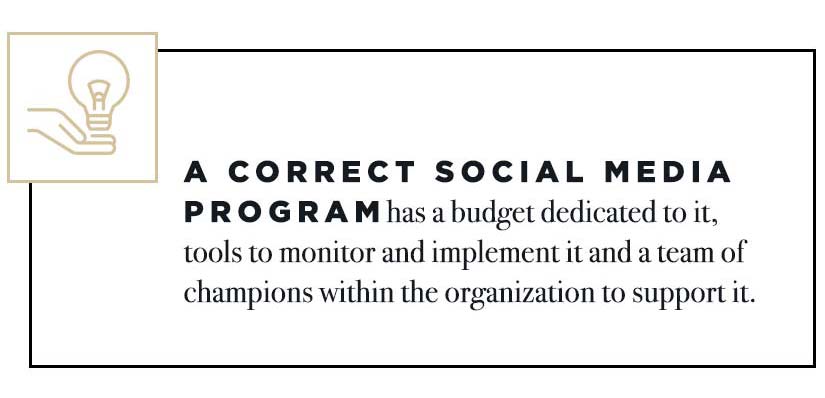
Your Essential Event Social Media Policy
Every event should have a social media policy. This should outline how to use social media to promote an event. Your team should be crystal clear about what is expected of them and the boundaries of their engagement.
A good social media program could easily turn into a depressing disaster if your staff are not clearly briefed about the rules of using social media in your company. There are also concerns with regards to respecting your employees’ rights when it comes to social media.
Some of the questions you should ask yourself are:
- Who is Involved? Who do I want to be using social media? All or part of my team? Who are those who can use it? Under what circumstances should they be using it?
- Disclosure. Should your employees add to their profile that they work for your event? Should they make a note that their words do not represent the employer’s views? Is there a difference between personal and business use? Should your employees have separate accounts?
- Key Contacts. Who should your employees contact if they want to engage with social media? Should they seek approval if they want to disclose they work for the event?
- Rules. Should your employees respect certain rules if they say they work for you but use social media on a personal level?
- Fair Competition. Are there ethical concerns your employees should take into consideration? Can they mention competitors? Suppliers? Can they disclose information about sponsors or general stakeholders? Is there a code of conduct they should adhere to?
- Profile Setup. Do employees business profiles have to meet certain criteria? Do you offer assistance in setting them up? Do you have a standard logo they should use? Should they use corporate photos on their profiles?
- Assistance. What general tips can you give about engaging correctly on social media? Expertise, attention to detail, knowing the language to use, do not take advantage of the community are just some examples.
As you may have noticed, there is a lot to go through. Depending on how you answer the above question, you could end up with a loose or strict policy.
As the Romans said, “in medio stat virtus” (virtue stands in the middle); meaning that a balance of the two practices is usually a good fit. You should not leave anything uncovered. You should protect your event reputation and brand but also preserve the right of your employees to express their views and in general not kill creativity and inspiration with too many rules.
It is in fact very common to see accounts of very strict companies that are just dull and uninteresting. There is an intrinsic component of social media that screams for personality, interesting content, creative updates, fun, education, and inspiration. Limiting your employees with too many rules may impact the delivery of any of the above.
On the other hand, being too laid back or too open may put you in a delicate position, exposing yourself to criticism and anger, two popular sentiments of social media.
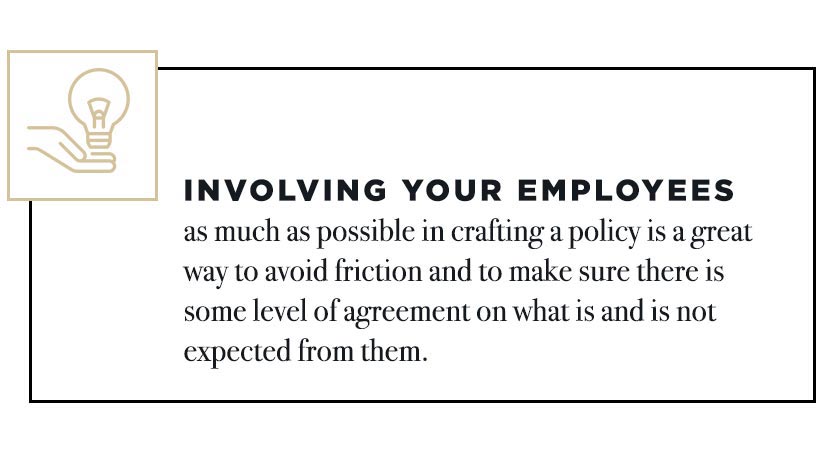
Involving your employees as much as possible in crafting a policy is a great way to avoid friction and to make sure there is some level of agreement on what is and is not expected from them.
6 Actions to Nail Your Social Media Event Marketing Strategy
When we think about social media for events, the first thing that comes to mind is event promotion. While social media is highly valuable for marketing, it’s scope and potential is much greater than that.
Social media can be used to add value to all the main business functions of your event. It can be used to stimulate engagement at the event, improve networking, manage customer service issues, direct attendees to relevant content and gather attendees feedback in real time.
Here we will look at six actions you need to take in order to nail your social media event marketing strategy:
- Define Objective Areas Where Social Can Help
- Map Your Processes
- Ask “What?”
- Ask “Why?”
- Ask “To Whom?”
- Ask “How?”
We’ve also included a handy social media event plan template and checklist for you to download at the end of the section.
Let’s look at each of those actions in more detail:
Action 1: Define Objective Areas Where Social Can Help
When putting your social media strategy together, it’s important that the objectives are in alignment with and help to achieve the overall event objectives. To work out how a social media strategy can help achieve these goals consider where social media can have an impact on your event.
Here are some of the definite objective areas your event can focus on:
- Customer service. Events with a well managed social media team can quickly and easily deal with problems like cold meeting rooms, lost property and session questions. They can also proactively provide valuable information such as delayed flights, reminders about when the lunch break ends and the location of an alternative washroom.
- Marketing. The viral nature of social media makes it a highly effective tool for connecting customers at all stages of the buying cycle. The focus is to better position the brand of your event into current and prospective attendees minds.
- Online Reputation Management. Traditional PR becomes reputation and brand management in a social media context. Social networks and social media are powerful tools to circulate a message, to change perception and influence the wider stakeholder community. The highly agile and responsive nature of social media means it is also ideal for dealing with crisis situations or averting problems before they start.
- Research. Social networks and social media are invaluable for researching the content of your event, potential speakers, performers, attendee profiles and so on. This information helps you to develop an appealing program and also provides a business intelligence to inform your sales and marketing. Setting up a good listening center will also allow you to discover what people are saying about your event, what they like about it and what their needs are.
- Sales. Social media has the ability to reach a large audience. However, that reach is only useful if you are providing valuable content and you respect the ethics and culture of different social channels. If you do that, then your audience will build in size and will be more open to direct sales campaigns and promotions.
- Event Engagement. Social is the perfect tool to foster more engagement during events, by means of gamification, live polls and Q&As, live streaming and more.
- Event Feedback. Feedback is no longer asked for, it is presented to the event planner on social networks. People are already talking about your event and your business online. You can tap into the conversation to understand both what went wrong and what was effective in your event.
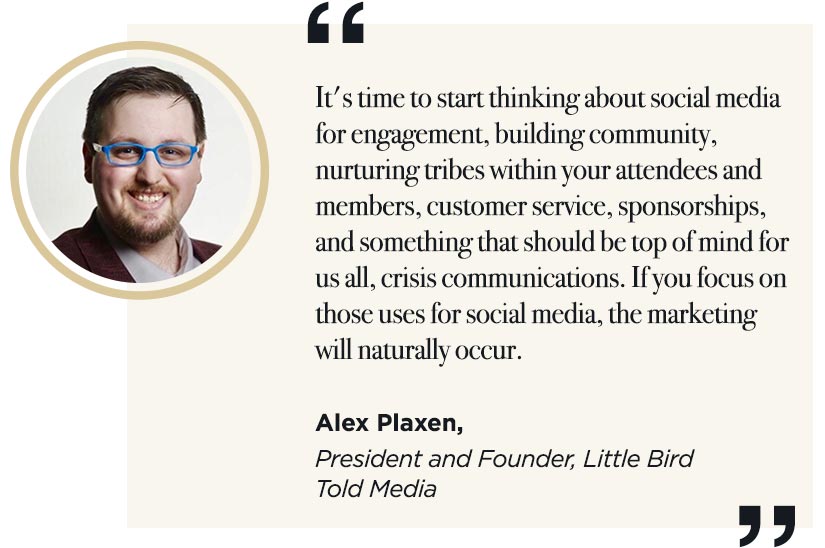
Action 2: Map Your Processes
Once you are confident with each business area where social media can help, it is time to understand where in your event or event business social media can give its best contribution. This is a procedure we like to call process mapping.
Process mapping consists of laying out all of the core touchpoints, user journeys and contingencies any of the stakeholders involved with your event will be affected by. The procedure involves using a whiteboard, a large sheet of paper or mind mapping software to lay it out.
If you use a template to project manage your event, you could use Work Breakdown Structures or detailed rundown sheets, these are very valid starting points for your process mapping stage.
This is an example of what a process mapping sheet may look like:
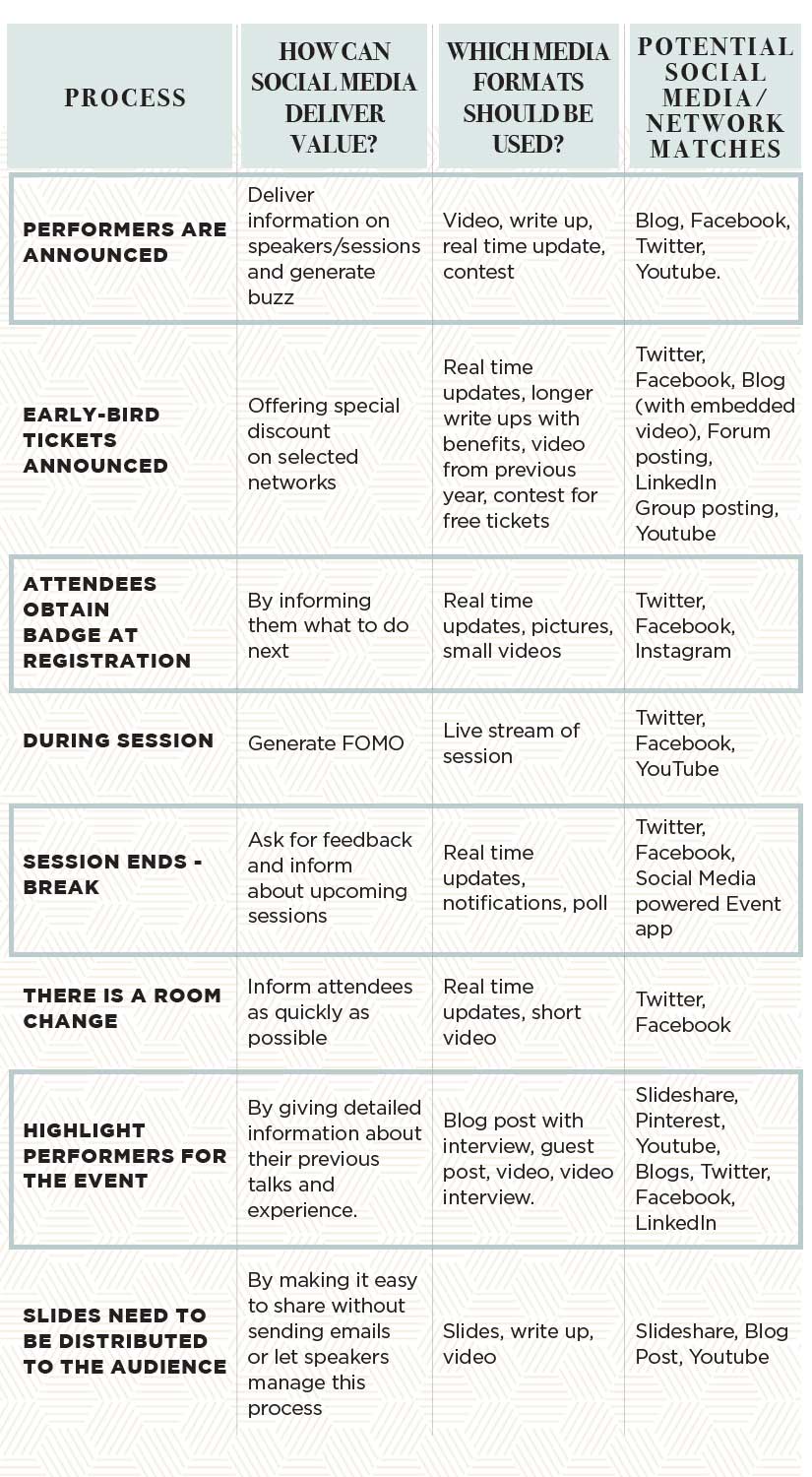
By thinking through all of the processes that make up your event you can easily identify areas where social media can help you reach economies of scale, avoid repetitive tasks or flood inboxes with unnecessary emails.
There is no need to be too granular about the process. It is also best to avoid uncertain areas. If the benefit of engaging with social media is not immediate, it means there is little value. Reconciling the process with a benefit should be an ‘aha’ moment, characterized by an effective and clear tangible outcome for the stakeholder involved.
It is also a good idea to prioritize the areas that need more help or present a better opportunity.
Action 3: Ask “What?”
What will you include in the content plan that will help to achieve your wider business objectives and specifically take advantage of untapped opportunities identified in your process mapping?
Be specific about the content you expect your team to create or find. This gathering stage will, in fact, involve identifying those sources of content that can help you to deliver value to your audience.
Different forms of content could include:
- Status Update
- Blog Post
- Infographic
- Webinar
- Video
- Image gallery
- Presentation
- White Paper/Ebook
- FAQs
- Your Website Pages
- Case Studies
- Client Testimonials
- Quotes
- Check-ins
- Contests
- Surveys
- Polls
- Live streaming
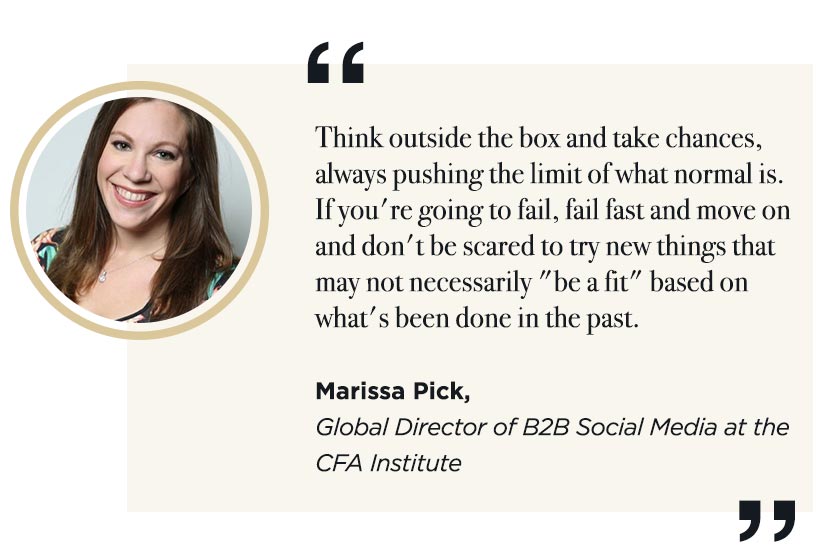
Action 4: Ask “Why?”
Why are you choosing to write about a specific topic? Why are you picking that news? Why are you resharing an update?
The why of your selection should be very clear to you and your team. It is very common to see completely out of touch or irrelevant updates being broadcast these days. To help you master content creation and selection correctly here is a handy checklist:
- Does the content help us in achieving our objective?
- Does the content deliver value to our audience?
- Is the content relevant to the context and channel we are using?
- Is the content helping our event or is it helping our competitors?
- Is the content educating, converting, influencing, serving or positively entertaining our audience?
- Is the content shareable? Will our audience recommend it to their peers?
It is very difficult to find universal values to give an indication as to why some content is more valuable, however, this is a good starting point to define why you are choosing to go live with the content you selected.
If you are not sure about one of these items, it is probably better to choose another approach or piece of content.
Action 5: Ask “To Whom?”
Who is the content addressed to? Do you clearly have in mind who your audience is?
The research phase of your social media program should identify key personas. It is a wise practice in marketing but also in PR and customer service to be confident with your audience personas. Choose two or three personas you should be talking to whenever you select, write, curate and publish content.
They should have name, age, occupation, income. This wayfinding and publishing content will be much easier. Will a teenager love a complex white paper? Probably not. Will a 56-year-old head of marketing be amused by a cat video on Youtube or Facebook? Yes (everybody likes cat videos), but will it be relevant for the right reasons?
Action 6: Ask “How?”
Defining audience personas will help you to set a clear tone and manner for your communications over social networks and influence content selected.
You should create specific guidelines in terms of how your team should communicate with your audience. Your brand values need to be reflected in all the communication over social media.
Our downloadable template will help you to further develop your strategy and social media events ideas:
How to Choose the Right Social Media to Successfully Promote Your Events
Selecting the right social media to promote your events makes you successful.
But how?
Social media is a necessity for event promotion but when done incorrectly can be a huge time suck with little return on investment. That’s why you need to be strategic about event planning social media.
Potential guests and attendees will be using some form of social media. But where are they exactly? Selecting the right platform to reach them is one of the most important elements to the success of your social media for events.
We will show you how to choose the social network(s) that best suits your message, brand and event to reach the widest, yet targeted, audience you can for event marketing. This includes actionable tips on:
- Defining your audience and learning where they can be found.
- Making yourself more visible through social profile optimization.
- Defining the type of follower relationship that is most effective on each platform.
- Considering which content is most suited to each network.
1. Defining Your Audience
How will you know where to find them, if you don’t know who to approach and market to?
The first stage of picking a platform is understanding the primary focus of each one, who is on them, and where your audience frequents. The first and second of this list are easy. Here are the basic focuses of each network and some suggestions for their best event uses:

Facebook – Think of Twitter but long term. Facebook can lend to meaningful, extended relationships with attendees that are more personal because of the amount of data that is held on their profiles. Once you have the loyalty, you are more likely to show up in their newsfeed and if you can get the reach, Facebook is probably one of the most wide-reaching platforms. Plus, it has better ad marketing targeting for different demographics simultaneously.

LinkedIn – For B2B marketing and making personal connections, LinkedIn can be perfect for finding sponsors, collaborations and letting influencers or industry professionals know about your event. Also excellent for finding professionals you want to hire for events or putting requests out.

Instagram – Another image focused platform that heavily relies on hashtags to be noticed. It can be an excellent place to group images of your event for a live wall (much like Twitter) and with Instagram’s new “follow hashtags” feature it makes searching and connecting with your audience easier. Also perfect for those behind-the-scenes images.

Twitter – For short bursts, updates, giveaways and flash ticket sales Twitter is an excellent platform that can also help build relationships with potential attendees. It allows effective and easier interaction compared to Instagram and Pinterest so it is better suited for quirky attendee contact, live streaming or Q&A sessions.

Pinterest – Image and inspiration heavy, if you are an eventprof looking to market by showcasing your event’s flair and style this is the choice for you. Many users on Pinterest don’t even look at the description (although that’s how you rank your pins well with SEO) but striking, eye catching images can entice others to click through.
Now you know what they are for, you can look at finding where your audience is based. This part can be a little trickier but there are a couple of things you can do now to help:
Do This Now:
- Check out your direct competition – Where they are, is where you should probably be. Particularly if you are aiming for the same demographic. Check out competitors social media and find which ones are most interacted with, and start with these first.
- Evaluate current analytics from your platforms – Download, link or look at the analytics, where are you getting most interaction? Likes, follows and shares equate to reach and engagement, look at where you are at currently.
- Ask – If you want to know, ask your attendees during feedback sessions or through questionnaires at your events and build a profile of where they are most likely to be.
2. Optimizing Your Profiles
Have you updated your social media profiles lately? It sounds simple enough, but often social media accounts’ bios and descriptions are outdated. For example, ever come across an annual event that still features information and links to its previous iteration two years before? We all have. In addition to that, most social media description fields are not being used in the most effective way to improve SEO, take advantage of new channel features, or promote other brand channels. Each social media network has its own opportunities for improvement.
Quick Tips to Profile Optimization
- Focus on one platform at a time. Choose the most popular or relevant to your content and update all of the information, re-write descriptions and make sure it is completely filled out. When you are done, move onto the next.
- Logout of each of your social media networks to see what your profile actually looks like to others. Google only grabs the information available on your public profile. Anything that is not publicly available will not be indexed by Google.
- Consistency. Ensure that you are consistent across all of your platforms. Are you using the same logos, colours, branding and style? If the answer is no, get to it. You want that instant brand recognition across all of your platforms.
3. Defining the Output
What do you want to achieve through your social media activity? Is it ticket sales, recurring event loyalty, relationships with industry professionals, targeted reach to update your audience? Deciding on what you need to achieve can drastically affect the platform that you use and how you use it. Point one touches the surface on what each platform can be used for but you’ll need to think carefully about your specific aims and motivations. You probably want to carve out a different aim and approach for each social media channel too, so give this some consideration.
3 Steps to Master Purpose
- Determine your purpose – what is your main goal for each channel?
- Highlight current relationships with your audience, can you build or expand on this? How can social media help you to meet your overall marketing goals?
- How will this evolve in the future? Look at the long-term prospects of each platform and how you will be able to use this as part of an ongoing strategy rather than just an event-specific one.
4. Create a Content Plan
Content is king so find out which will be most effective to your audience. Videos, live-streams, hashtags, quotes, infographics, ebooks and images are all types of content that can be effective to boost your event social media so consider what you have to offer and choose the platform that responds to this best. If it’s videos, create a YouTube account and share these links across your other social media, if you have stunning images and ideas then Pinterest or Instagram will help you the most.
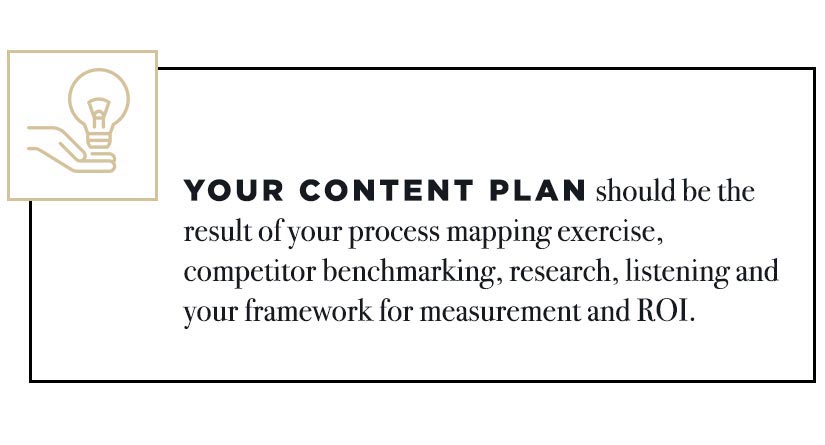
Your content plan should be the result of your process mapping exercise, competitor benchmarking, research, listening and your framework for measurement and ROI.
What will you include in the content plan that will help to achieve your wider business objectives and specifically take advantage of untapped opportunities identified in your process mapping?
Types of content that can be very engaging include:
Memes
Memes can really resonate with social media users but there are dangers of jumping on the latest thing. It’s all about context. If you feel you have the full context of a meme and it tells your story, jump on it fast before fatigue sets in. Check KnowYourMeme.com before you use them.
Emoji
The biggest mistakes brands make when deciding to include emoji in their communications are overuse and lack of understanding. To use emojis natively and correctly, you have to make sure the person executing your communications understands the nuances between what they officially mean and how they are popularly used. The other factor to be aware of is fatigue and oversaturation of the use of some emoji. Above all, be authentic. It’s very difficult to maintain inauthentic forms of communication.
Humor
No one wants to share a boring product post or call to action with their friends but they will share something funny. If you can tell your story in a humorous way, you’ll earn more attention. Know the line for the voice of your brand or event and the audience you are going after, but don’t be afraid to experiment a bit.
.gifs
Culture has become a form of communication in its own right and the rise of .gifs as content supports this. Giphy.com is the world’s largest repository of gifs. Looking to create your own branded .gifs? EZgif works well for your desktop and Giphy Cam can give you what you need on the go for mobile.
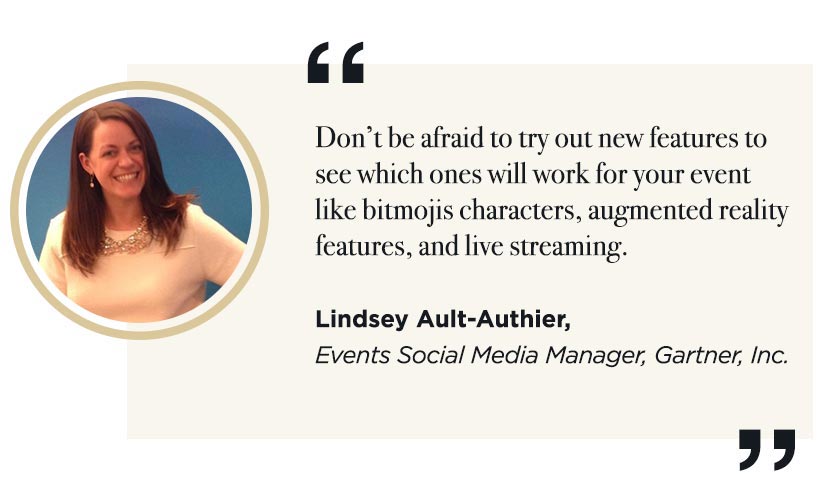
You should be very specific with the content you expect your team to create or find. This gathering stage will in fact involve identifying those sources of content that can help you to deliver value to your audience. In fact having a content plan does not mean always creating new content.
Defining Your Content Quickly:
- Find out which content commands the most engagement on each of your social media platforms. This is something you want to monitor consistently.
- Which content can you easily create that is going to set you apart? Enhance this and focus on ways to improve it.
- Experiment with A/B testing on your social media channels and post different multimedia that you haven’t explored to find out if it outperforms your original content.
- Think about:
- Existing internal content that you can repurpose in new formats.
- Existing internal content that you can share on new channels.
- External content which can inspire and be the basis for new content creation.
- External content that can be curated and shared via social channels.
Strategy Requires (Regular) Posting
Ensure you post regularly and have an active account. It sends out the wrong messages and discourages people from following/liking/connecting with you if your channel is silent or shows irregular activity.
If you work to build a community for your annual event ensure that you continue to post all year round too, don’t commit the ultimate sin and only pay attention to it around your approaching event date to try to stimulate sales.
5. Growing Social Media Engagement
The viral nature of social media makes it a highly effective tool for connecting customers at all stages of the buying cycle. The focus is to better position the brand of your event into current and prospective attendees minds.
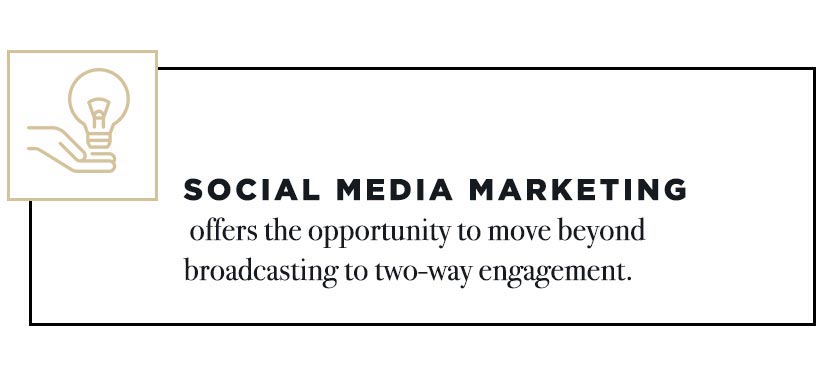
Traditional forms of marketing (print, TV, radio) focus on broadcasting, where information flows in just one direction. Social media marketing is distinct because it offers the opportunity to move beyond broadcasting to two-way engagement. When you can engage your audience you get to leverage their networks and your marketing reach can grow exponentially.
Your audience are on a spectrum from:
- Not interested: whatever you post is just noise.
- Mild interest: they notice your social media posts and have a thought that they might take a look later.
- Passive viewing: your posts show up as interesting enough to click on and read.
- Active interest: they are clicking on links, liking posts, sharing, retweeting
- Fully engaged: posting their own content, uploading pictures, engaging in discussions
Create a social media strategy that speaks to these different audiences and helps them move up the ladder to full engagement. If you have fun using using social media at events it will show through and create more authentic engagement.
Grow Relationships with Your Followers:
- Set aside time every day to listen and interact with your followers.
- Have genuine conversations, not just sales messaging.
- Use social media to do things to surprise or showcase your followers.
- Post challenges and ask your followers to share their own content and insights.
A Complete Guide to Promoting Your Event Hashtag
Hashtags are nothing new but having a consistent hashtag strategy for your event is important on so many levels, including:
- Consistency. Having a hashtag and communicating it clearly makes sure that your attendees can consistently interact at different social touchpoints. Your hashtag is the universal currency that makes social exchange possible, the Rosetta Stone of interaction.
- Empowerment. Having a clear and concise hashtag strategy enables your attendees to know exactly how to interact with you. Not knowing how to interact strongly limits the desire for expression during the event that we all experience as attendees.
- Awareness. Communicating your hashtag to the audience changes perceptions. It shows you are recognizing the attendees’ need to express themselves socially at your event. They will perceive you as ‘up to standard’ and ready to cater for their social needs.
- Analysis. Your hashtag is the most precious tool to collect all the conversation around your event. Any public update with your hashtag will be easy to curate, whether you are using a live social wall aggregating all the conversation at the event or social media monitoring software.
- Engagement. Several tools that stimulate discussion and live interaction at events such as Audience Response Systems and Mobile Apps need hshtags as means of public interaction. You can vote using hashtags, you can ask questions using hashtags.
- Crisis Management. Your hashtag is the perfect vehicle to quickly spread the news about potential crisis that may arise. Your hashtag is a communication channel with an audience waiting to read the latest updates or looking at media generated.
- Distribution. The hashtag is also the official backchannel of your event. It is your virtual chatroom where you can make announcements, stimulate discussion, inform about your program and promote aspects of the event.
- Feedback. A hashtag is the social vehicle to funnel and collect feedback. It will be very difficult to find complaints and compliments about your event if you don’t have a hashtag in place.
- Community. Having a hashtag in place ensures that the life cycle of your event stretches substantially. Attendees will be able to discuss the event before it actually starts, they will feel connection to the community much earlier. By the time they get to the event, they will experience a feeling of confidence with the event and other attendees. That creates the feeling of continuous communities which events need.
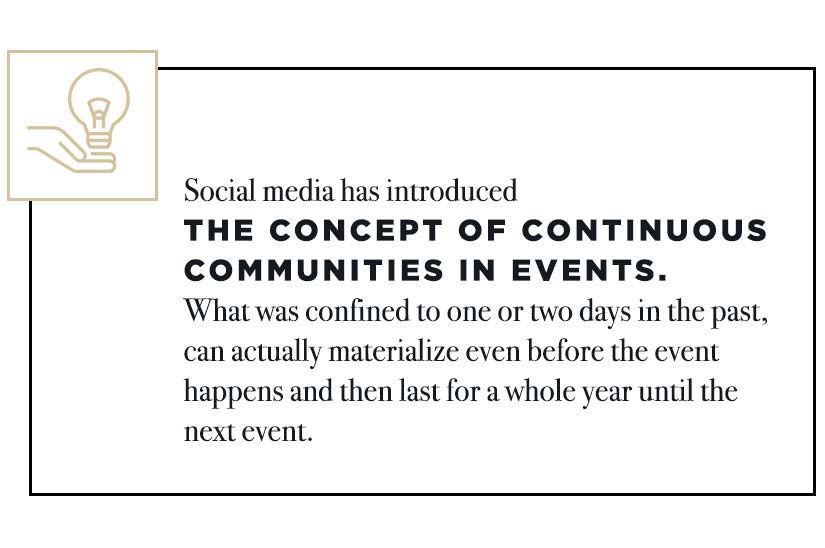
- Networking. The event hashtag is the prime medium of networking. Attendees can relate to each other by checking the hashtag on their social network of choice. It will immediately answer the question ‘who is attending?’ which sometimes cannot be answered for privacy concerns. Attendees using the hashtag make a statement that they want to be overt about their attendance and connect with the event or fellow attendees.
How to Choose the Perfect Hashtag
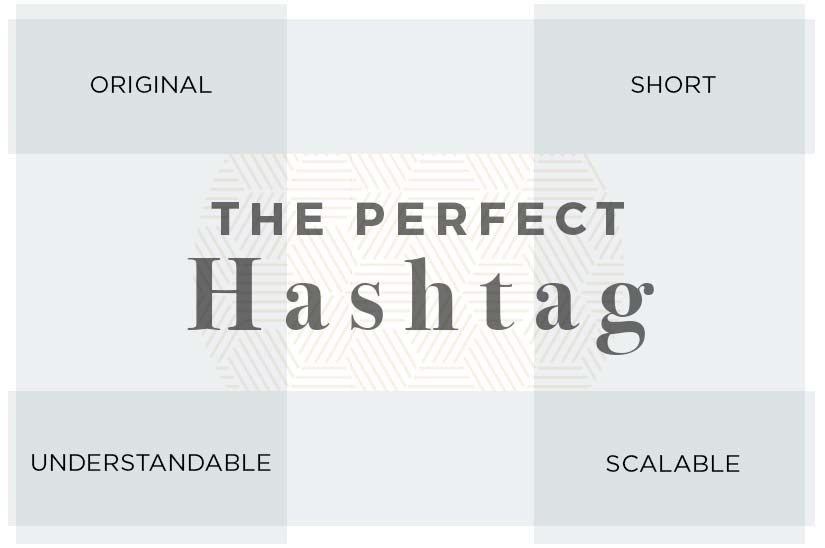
Before deciding on your event hashtag you need to find one that is:
- Original. Make sure no one else is using the same hashtag. Research all social networks you will select for current uses of your ideal hashtag.
- Short. Some social networks limit the number of characters available. Picking a short hashtag guarantees saving precious real estates where needed.
- Understandable. Your hashtag should be easy to understand. It needs to have cues to the name or content of your event. Acronyms are welcome but it needs to be somewhat evident.
- Scalable. You need to be able to scale your hashtag for future versions of your event. Attaching the year as a suffix is widely adopted strategy as in #event18 #event19, reinforcing the need of a short hashtag.
19+ Pre Event Hype Ideas For Social Media
Attendees talking about your event are attendees marketing your event for you. However, coming up with ideas to spark the right conversations isn’t always easy.
No worries, because we’ve pulled together some of the best ways to bring the buzz to your social media and get attendees and followers talking.
Attendees often talk about events on social media before they attend them so it pays to leverage this and boost anticipation.
For effective social media promotion, you need to share valuable content, create buzz and build momentum throughout. Here are some of the best ways of using social media at events:
1. Boost Excitement With Pictures from Last Year
Post last year’s pictures and/or turn these into image memes. If you’re using pictures of people and not just food and location, make sure they are all flattering. You don’t want someone who hates that photo of themselves to get angry with you. You can also ask to use images from attendees themselves, quoting or tagging them once they say yes to showcase real examples of people who enjoyed the event.
Be An Image Master:
- Use an app to create these on your phone. You’ll save time since that’s where your images are anyway.
- Overlay quotes and testimonials from your event over pictures taken there.
- Take your funny shots and ask people to caption them.
2. Bring The Event to Life With Video
Put together a video of last year’s footage or a picture montage set to music. People love to see themselves or check out if they knew anyone who attended last year. Make it fun. Post it to Facebook (don’t forget to feature it on your page) and to YouTube (the #2 search engine in the world). Tag the videos accordingly.
Embrace the Power of Video:
- Create a video that explains how to get the most from your event.
- Publish a video series entitled “Insider’s Guide to Your Event.”
- Give video help on a side topic like networking or navigating the host city.
3. Create Visual Testimonials to Build Trust
Go through last year’s comments, emails, and surveys. Pull out flattering quotes and marry them with an inspirational image. Using photos of the host city as the backdrop for the visual quote is a nice touch, so is using pictures that match what the attendee is referring to. Be creative and use striking visuals in order to get noticed.
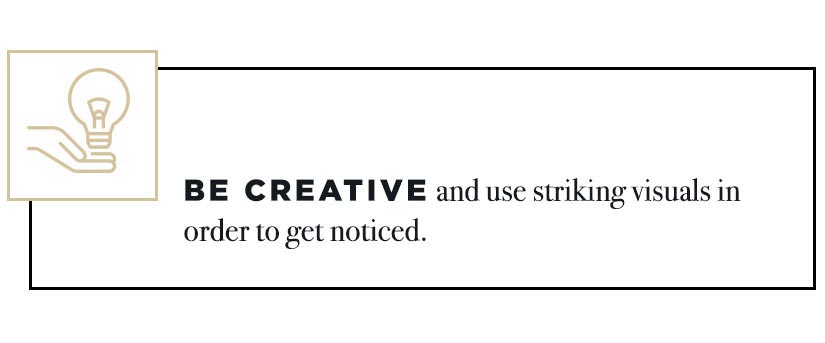
Become a Picture Pro:
- Ditch stock photos and take your own. Play around with angles, focus, and cropping to create cool backdrops for quotes.
- Add a watermark or hashtag on each image quote.
- Ask the person quoted if they would be willing to share it with their network. You can do this when you’re asking to use it.
4. Keep It Simple – Use One Hashtag for Your Event
Easy search. End of story. Don’t muddle your social media efforts with multiple hashtags that no one will remember. Choose one and stick with it. Share this hashtag with everyone. You can even place it on table cards and presentation slides at the event.
Make the Most of Hashtags:
- If this is the first time using your hashtag, run a quick check to make sure no one else is using it.
- If your post scheduler allows it, add your hashtag ahead of time as a template on your posts so that you don’t misspell it in the moment.
- Keep your hashtag as short as possible. That leaves room for more messaging.
5. Give Your Ambassadors Special Treatment And They Will Return The Favour
Give your ambassadors and past attendees discount codes they can share and track the code provided so that you can see how far the referrals are reaching. Provide them with visual content to share and ask them to. Some associations and businesses offer a referral contest to increase word-of-mouth marketing. Not only does this appeal to the people receiving the discounts, but their referrers feel special that they are able to offer an exclusive opportunity to their tribe. At TechFest, the Event Organiser announced that the top tweeters at the event should come for free to the next year’s event as they were that valuable to him.
Grow Ambassador Loyalty:
- Create a shared space where they can access all the information they’d need to share in one spot.
- Put them on a drip marketing campaign or ask them to join a private Facebook Group where you can share things just with them. It will also make them feel special to be included.
- Thank them regularly and have some swag waiting for them at check-in.
6. Use Giveaways To Incentivize Engagement
Run a giveaway that involves signage, sign-up pages or notification about your events. It’s an excellent way to not only boost your email list but highlight your event to a wide audience and make sharing posts a prerequisite. Be careful not to let your audience know that your giveaway is not in association with the platform you are promoting on (unless of course they are sponsoring it for you) otherwise this could break terms and conditions.
Master your Swag-ger:
- Use different types of giveaways from swag to discounts.
- If you send a piece of swag, ask that they share a selfie (using your hashtag, of course) with it.
- Announce the winner via a livestream video.
Want to know more about contests as a pre-event hype tactic?
We’ll cover it in detail in the next section but keep reading for more awesome non-contest hype ideas.
7. Build Anticipation With Teasers and Countdowns
Tease new tidbits of exciting information about your event in advance to get people excited but make sure it’s details that are going to pique interest. From line-ups, influencers that may be attending as well as celebrity guests or entertainment that you expect to be a hit, it all generates that buzz and gets people talking.
Countdowns are also excellent and can coincide with giveaways to keep your audience coming back to your channels regularly closer to your event to keep it in the forefront of their mind.
Drip Content like a Boss:
- Find a post scheduler you like.
- Schedule your teasers and countdowns as autoposts.
- Check back and answer or respond to comments.
8. Share on Different Platforms For Maximum Reach
Don’t just stick to the same platform, share your content across all of them. You may be focusing most of your efforts on one or two but take a few minutes to appease your fewer audience members. All it takes is one viral post to get decent reach and boosting on different networks can help be seen multiple times and shared.
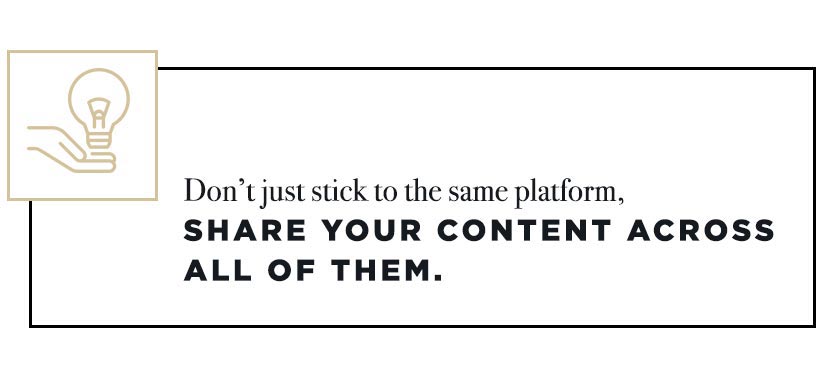
You may notice that a potential attendee skimmed past it on one platform but then sees your post again and clicks on it. Cross platform promotion reaffirms your message as well as broadening your reach. The messaging doesn’t have to be the same for each platform it can be shared in a slightly different way for each.
Be a Social Media Explorer:
- Use a scheduler that lets you copy posts easily and change them slightly.
- Explore the possibilities of IFTTT to populate social media platforms when you post to one profiles.
- Watch your analytics to see what people are responding to on each platform and then do more of it.
9. Entice Attendees With Exclusive Offers and Discounts
Early bird offers, pre-sales, registration and follower (or subscriber) only discounts makes following more valuable as they get something back. The incentive to stay clued in to your channels is higher because they can jump on the exclusivity you provide. Plus, if you do this at random intervals they won’t know what to expect, making it more exciting.
Become a Gatekeeper to Drive Interest:
- If you want to drive exclusivity, only announce on the channels you say you will. If others see you advertising it all over town, they won’t see a reason to follow you.
- Do something truly exclusive for your social media following.
- Use Snapchat or a story on Facebook or Instagram to offer something for 24-hours only. After that it will disappear.
10. Give Behind-the-Scenes Access To Create a Personal Connection
Offering set-up, backstage or behind the scenes access is another exclusive offering that is cost-effective. Many attendees are interested in what it takes to create an event and allows more of a personal connection to your channels which audiences enjoy. Seeing the face and effort behind an event can also make it more tangible and therefore exciting as it draws closer.
Plus, you could offer sponsorship ideas or discounts with suppliers if you give them a shout-out for using their products and services during set-up.
Be a Behind-the-scenes Ninja:
- Live stream your arrival at the host city or venue.
- Sneak into the kitchen and interview the chef.
- Have a little fun with the keynote or presenter and ask them to share a secret talent with the audience.
11. Make Attendees Feel Important With VIP Packages
Whether this is via giveaways or simply offering limited amounts of packages, you can create a hype surrounding these extra offerings. There are two main types of VIP offerings – access and audience. People will pay extra to do things like gain early access for tickets that sell out or have an audience with someone special, like meeting the keynote speaker in a private cocktail reception.
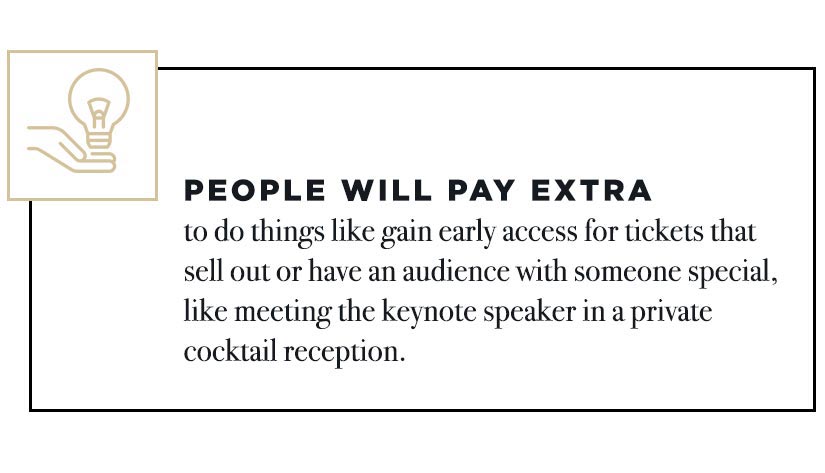
This is not a new concept. Think about how people pay for front row seats at concerts or pay extra to board airplanes first. Social media has helped drive this interest in being one of the select few, especially because that then means the attendee can broadcast the entire experience.
There’s that word-of-mouth marketing again!
Kick VIP Up a Notch:
- Figure out what your audience members will pay extra to be able to do.
- Offer additional opportunities and upsells. For instance, if you offer a package to meet the speaker in a cocktail reception, offer a higher package to have a picture taken and sit with them at their table.
- Capture these specials on video and camera. You’ll want to use them in marketing next year.
12. Use Speaker Interviews and Supporting Content To Build Interest
Speakers are a major draw for any event. Giving your attendees a little early access to them through an interview, book offer, special webinar (for early-bird registrants), an online community, call-in Q&A session, or other form of special access for those who have registered can be a boost to early registrations and interest.
You can also spark interest through your speakers providing content like guest blog posts, social media posts (from their accounts using your hashtag, of course), an inside look into what they’ll be talking about at your event, or any other content.
This benefits you because it increases event interest and attendee numbers, helps the speaker connect early with the audience, and acts like a content teaser getting your audience excited about what they will soon be a part of.
Embrace your Inner Oprah:
- Conduct the interview on Skype or Google.
- Use the content in multiple ways by transcribing it, creating an audio, and a video out of it.
- If your speaker is well-known, ask them to do a quick clip asking people to register for your event. Think of it as a celebrity endorsement and since it can be done at the same time as the interview, you’re not asking for additional time.
13. Increase Momentum – Ask Your Ambassadors and Early-Birds to Share
As we mentioned above, word-of-mouth marketing is crucial. In addition to encouraging advocates to share your posts and their own, ask if some of your most loyal attendees wouldn’t mind blogging about your event.
Encourage Blogging Around Your Event:
These posts needn’t be testimonials on your awesomeness, they can also be helpful resources on topics. Suggest potential topics and questions your customers are asking, in case your loyal attendees are happy to share content, such as:
- What a Newbie Needs to Know About Attending ______
- What to Pack to Attend ______
- Must Do’s at _____
- The Best Thing About ______
- Tips for Exploring <the host city>
14. Gamify Your Pre-Marketing To Build Advocacy
If you have an online community, app or group, you can gamify the pre-marketing experience. Give attendees points for things like early registration, referrals, social media shares, and any other activity you want to drive. Post a public leaderboard on social media so others can see your super ambassadors. You can even take a tip from the airline loyalty programs and create memberships based on their points levels. When someone achieves a gold level for their efforts on the activities you deemed important, you could reward them with a credit in the bookstore, a refund or partial discount on their ticket price, or free ground transportation or upgraded room.
Gamification needn’t all be about competition. There’s plenty of room for fun too. Twitter leaderboards, robots that blow bubbles the more Tweets that are sent, unlocking rewards when keywords are mentioned using the hashtag and photo booths that can share pictures to social networks are all ideas we have used and love in our events.
Be a Game Wizard:
- Find out if your event app has a gamification feature. Many do.
- Think about what activities you want to drive and use those as the basis for your points.
- Bolster competition throughout the day by giving reports on how others can join in on the fun.
- Use emojis to gamify and gauge different reactions in a fun way to get feedback on a post.
15. Promote The Experience By Talking Up the Venue or the Host City
Get your crowd excited about where they’ll be. If this is a multi-day event, create plenty of content surrounding your host city. Sometimes the location can be enough of a sell on its own but only if you give it top billing. Use video, pictures, live stream from a site visit, and turn to the CVB for help too. They have plenty of resources for you.
If your event is only a few hours, don’t miss the opportunity to showcase the venue. You chose it for a reason. Share your favorite things about it. Their sales department can help you with images and maybe even video footage.
Embrace your Inner Cruise Director:
- Ask a local Facebook group based in the host city the best things about the town and share it with your audience.
- Find out a fun fact about the town or venue and share it or ask people to guess the answer to a trivia question about your event spot.
- Listen for people talking about the host city and share pertinent information.
16. Create a Serial to Build a Loyal Following
It’s a format that’s been used for decades – the serial. You leak a little now and post a little later. People know what to expect because your posts are consistent. This keeps them coming back for more.
Post lists but break them up into daily posts. Instead of posting “7 things we love about <host city>” tease your audience to let them know that next week you’re posting something you love about the host city every day. At the end, you can compile them all into a visual post and share that as well.
Try Your Hand at Dealer Dealing Out Awesomeness:
- Schedule these types of posts in advance.
- Curate the content. You needn’t create your own. Chances are there are posts like this that you can borrow from (with attribution, of course).
- Do something unusual like creating a playlist of music tied to the town and share a new song each day.
17. Advertise on Social Media To Reach A Bigger Targeted Audience
Don’t forget that targeted advertising on social media is one of the best, most cost-effective ways to reach your ideal audience. Plus since many sites show followers and friends what their network is doing, people will see when others like your event or say they plan on attending.
Spend a Little Money to Make Even More:
- Always include a link to your event registration page. Ticket purchases are emotional buys. If your marketing is so superb someone feels motivated to give you their credit card number, you want to make it as seamless as possible. If not, they may decide the ticket purchase isn’t worth the hassle.
- Use the targeting feature on your social media platform of choice to ensure you narrow down the field so you don’t overpay.
- Create an ad with a need in mind. How does your event meet that need?
18. Listen on Social Media to Learn and Grow
Social media is a fantastic listening tool and provides a wealth of information for you. Take advantage of this opportunity to listen to what people are saying about your brand and events and find out what makes them tick. Tap into popular hashtags and chats, communities, etc to keep ahead of trends.
But, remember…
Listening is only as good as its application. Use your newly gained knowledge to create more opportunities to delight your attendees, engage them in conversation, and reach out to others to increase your audience. Listening without (then taking) action or as part of a conversation is a little creepy.
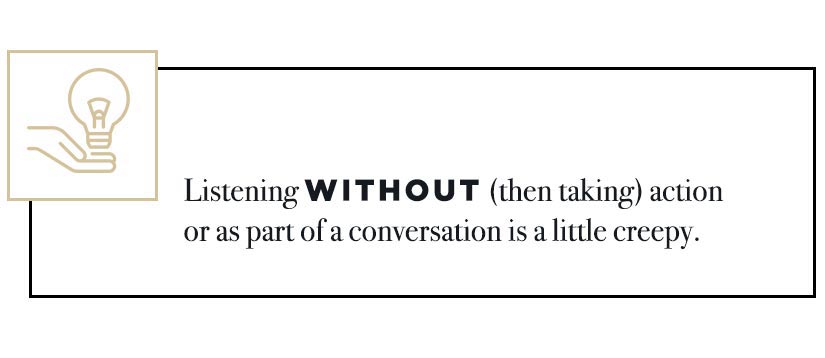
Grow Big Ears:
- Use a listening platform to research what other events with similar demographics are doing. Note how their audience is responding on social.
- If your event has a broad audience and appeal, look for people talking about being in or visiting the host city at the time of your event and invite them on social media.
- Listen for problems and offer solutions without being salesy.
19. Respond Like Your Life Depended on It
Social media is active 24 hours a day, 7 days a week and it is important that you can respond swiftly. Event attendees will often expect a response within the hour. This is particularly important if you encounter any negativity – ensure that you can react promptly and resolve the issue and/or take it offline. We’ll address more about this in the handling a social media crisis section below.
It may not seem like response is a great way to build pre-event hype but it is. Imagine someone’s surprise when they tweet about registering late at night and you respond with how excited you are to meet them or for them to see what you have in store. It makes an impression.
Be on High Alert:
- Set up notifications so you are aware of direct mentions and messages and are in the best position to respond quickly.
- Ensure you have the relevant apps on your mobile device so you can check and respond to social media channels in any free moment, even when away from the office.
- If you entrust someone else to handle social media for you, make sure they understand the chain of command for not only dealing with crisis but compliments as well. Favorable comments deserve responses too.
Paid Social Media Advertising: Improve Your Targeting To Increase Ticket Sales
Social advertising is available via all of the main social networks. It can be an inexpensive and effective way to reach your ideal attendees and can even give your organic results a little boost. Many social media platforms now feature advanced targeting to make sure the right message gets to the right people. For instance, if you’re hosting an event where you want a group of people from a particular area to attend, you can set geographic limits so that only people in a particular area are notified.
Top Tips for Social Advertising Results:
- Use geo-targeting to get higher reach and lower cost per interaction than non-geographic targeting.
- Take time to understand the specifics of each different platform to get the most from it.
- Set a budget limit and how it is spent.
- Drive more ticket sales by employing retargeting in your marketing efforts. Depending on the platform, and the limitations you place on it, it can be inexpensive to do. Reappearing in front of someone who visited your site but didn’t register for the event or buy a ticket can increase sales.
- Use automation to create a drip marketing campaign that will help you stay in touch with attendees or fans and keep them aware of upcoming events, drip feeding content in a specific order.
Your 4 Step Action Plan to Working with Social Media Influencers
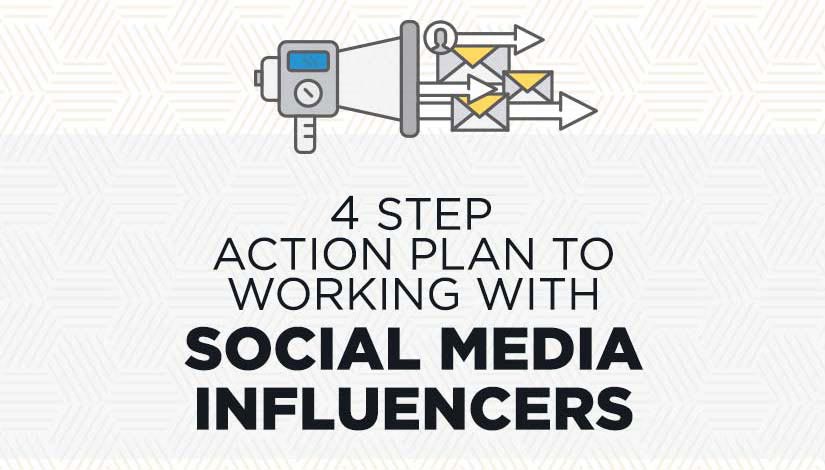
There is no better marketing than a recommendation from someone people trust. According to Shopify, 84% of people will take action based on the opinion of others, so get influencers on board early (and often).
Influencers have spent time and energy building a huge following and developed rapport and trust with their audience that your event can tap into. These trendsetters can let your audience know about your event and when added to your event marketing strategy, they can help extend your reach and credibility to your existing demographic and new potential attendees.
An influencer merely mentioning an event on social media can spike interest, showing their audience that you are worth it (so you better live up to that expectation.) If you’re hosting an event, you shouldn’t discount an influencer’s growing power so here’s how you can get started, particularly with YouTubers, Instagram influencers, and Snapchatters.
-
Assess the Environment
First, take a look at what others are doing. This starts with the big events and competitors out there. Check what they’re sharing and what gets the most engagement. Next look for popular people, products, and services that serve your ideal attendee demographic.
Take Note:
- Use technology to identify and search a database of influencers who are all interested in working with marketers and event planners.
- The number of followers is less important than the amount of engagement. Instead of being wowed by their numbers look at the interaction rates and their rapport with their fans.
- Don’t just look at the big names. It may be more realistic, achievable and targeted to work with a number of micro-influencers instead.
- Do any of the influencers you have identified have links with other events? If they have an agreement with your competitors it probably rules them out. Find your own star.
-
Approach the Influencer
If you have your heart set on working with one of the biggest influencers, with millions of followers, you will need to be prepared to pay for that privilege. They’ve been there, done that. Chances are they’ll already have agreements they use, and often they will have an agent that will handle all of the communications and negotiations for them. They are hot property and demand high fees accordingly.
If you’re approaching a micro-influencer, new talent, or someone who hasn’t been involved in working with an event you’ll want to have a conversation about the details of their following and whether that demographic matches the one you’re trying to attract.
If they can’t tell you anything about their audience, move on. Most of these influencers are highly engaged with their community. They know what they like and what they don’t. They should also have an idea about the demographic they are most popular among. If they don’t, that’s a sign they’re either not paying attention or they’re not that engaged.
Get the Approach Right:
- Make sure you have done your homework and researched the influencer. Mention some of their recent posts/videos or something they have done that really captured your imagination.
- Be able to explain succinctly your event and why you think there could be synergy between the two.
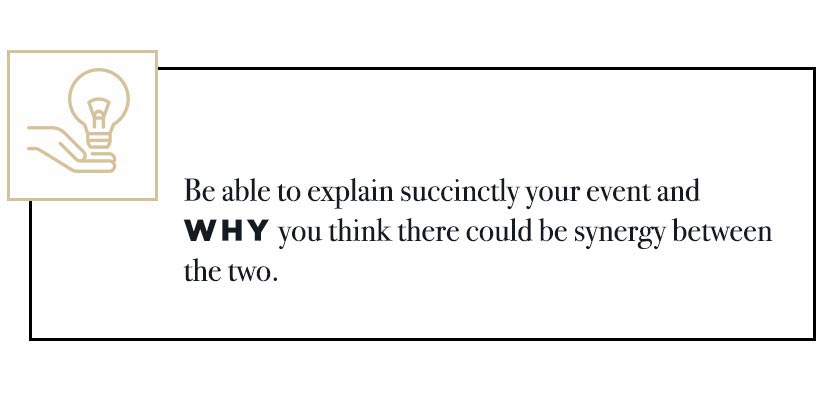
-
Convey Your Goals
There is no point in approaching an influencer if you don’t know what you want him or her to do. Most likely you want help with attracting a particular demographic to your event but whatever your objective do make sure the influencer knows what you’re looking to achieve. Influencers understand their audience so avoid giving them specific directions on how to affect the outcome. Instead, tell them what your end goal is, how you plan to measure it, and educate them on your event as in who attends, what they like, and how you present yourself. You want that to be consistent with what they are presenting to their community.
- Top Tips for Getting the Most from Influencer Relationships:If it isn’t a good fit, it is best to walk away now rather than to have unrealistic expectations. For instance, if a YouTuber has millions of followers but they are mostly teenage girls from Asia, they are unlikely to come to a one-day event in the UK, just because their idol will be there.
- Ask, and listen to, ideas that the influencer can suggest.
- Trust the influencer and be open to taking risks, based on the advice of the influencer.
-
Offer Materials They Want
Once you’ve figured out how they will help you (i.e. giving their followers a special attendee discount), and negotiated the terms in doing so, you need to give them any materials they need to share with their network. Most often this is a landing page and discount code that is personalized to their efforts but it could also include video, logos, graphics, and other collateral.
Give your influencer some creative leeway as to how they share the materials and information with their tribe but, as mentioned earlier, you also want them to know how you’ll be tracking results (click-throughs on your landing page, sign-ups, etc.). Don’t forget hashtags, and conveying clearly what content output you expect and what you would like to hold rights to.
Suggestions for Maximum Success:
- Never force an influencer to share messaging you have created. They need to be authentic and do it/say it/deliver it their way, otherwise it will appear false and resonate less with their fans.
- Agree how you will share progress updates, so they know the results coming through and can adjust their strategy accordingly.
- Set timescales for key milestones and to ensure that their efforts fit in with your wider marketing strategy.
Be a Master of FOMO With Pre-event Social Media Contests
With the right timing and pre-planning contests can be high reward ideas for giving social media platforms the extra boost. However, social media contests can seem like a surefire success engine for greater sharing and engagement, but they can also be just as difficult to plan and execute as the event itself. Excellent social media contests require substantial planning and nimble execution. They have many moving parts and potential points of failure.
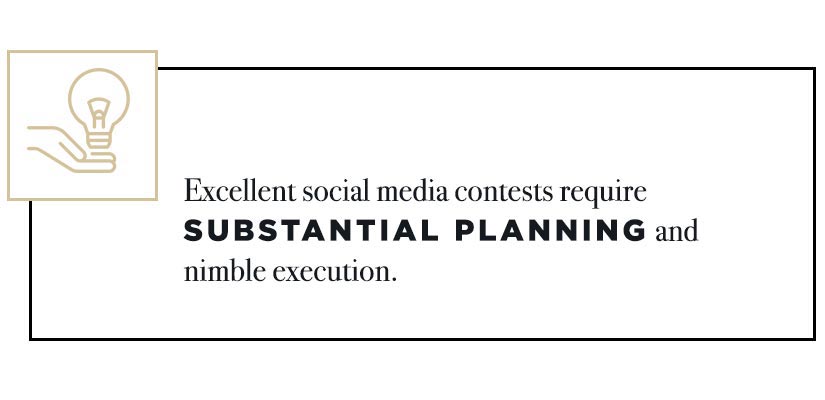
Follow these guidelines now to create FOMO with your social media contests:
1. Get Meaningful Interaction by Targeting The Right Audience
To make an effective social media contest, you must identify the type of participant you are engaging. This helps you to think about the best kind of contests and incentives and also helps you to think about which channels to use and the level of technical assistance you may need to provide. Ask the following questions:
- How tech-savvy is your audience?
- What types of social media channels are your intended audience already using?
- What are the types of things your participant likes to do? How are they already sharing on social media?
- Where is your ideal participant most likely to hear about your social media contest?
- What would compel your ideal participant to engage with the contest and/or share it with their friends?
- What behaviors or call-to-action do you want to encourage?
2. Know What Good Looks Like: Clarify Goals
If you want to incorporate social media contests into your strategy, you should identify clear objectives for the contest at the outset. Consider how these goals will impact the overall event objectives. Some example goals might be:
- To encourage buzz or social media engagement around a brand, event or product..
- To grow your email list.
- To reward your most engaged fans.
- To collect user generated content.
- To highlight features you want more people to notice or talk about, like: innovative design, clever brand experiences, or brand partnerships.
3. Increase Competition Entries By Keeping It Simple and Accessible
Think about which type of contest will reach and engage the largest number of your intended audience. Establish a low barrier of entry and make it super simple to participate. The more steps it takes to qualify in a contest, the fewer participants you will have.
Tips for lowering your barrier to entry:
- Base competitions on actions the audience are already performing
- Map out the contestant journey and remove unnecessary steps
- Consider rewarding people at all levels of technical proficiency
4. Drive Entries With Compelling Incentives
The general rule of thumb is that the bigger the prize, the more engagement you will get but whether or not that helps you achieve your contest goals is another matter. Here are some tips for choosing the right incentives for your audience:
- If your brand produces products or services, use one of the most popular items as a star prize.
- Provide rewards that support participants’ social media efforts or inspires ongoing engagement
- Consider a prize that will compel them to keep talking about your brand
5. Know The Rules Before You Start
Each social media channel has different rules and different territories have different laws for hosting contests. Save yourself headache and heartache by knowing them before creating your contest. Here are some important considerations to make about the terminology you use in your contest rules:
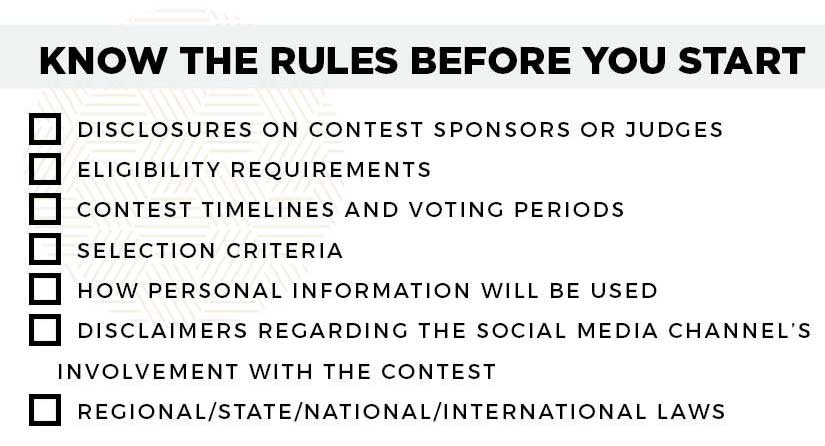
- Disclosures on contest sponsors or judges
- Eligibility requirements
- Contest timelines and voting periods
- Selection criteria
- How personal information will be used
- Disclaimers regarding the social media channel’s involvement with the contest
- Regional/state/national/international laws
6. Timing Is Everything
When your competition happens and how long it lasts are important factors that affect overall engagement. When contests are too short, there is a greater likelihood that you won’t get the results you want, since you likely won’t have enough time to promote it and users won’t have enough time to participate. When contests are too long, participants can lose their sense of urgency or simply forget about the contest all together.
Get your competition timings right with these tips:
- Make announcements at the times your audience is most engaged
- Give attendees enough time to complete competition tasks
- Keep the contest short enough to keep up urgency
7. Promote Beyond The Website To Maximize Your Audience
There are many ways to reach people beyond your event homepage and although we’re talking about social media, not all promotion has to be online. Here are some ideas for promoting beyond your website:
- Depending on the scope of your contest and the audience you are trying to reach, investing in Facebook, Instagram, LinkedIn, or Twitter ads is a great and affordable way to increase the reach of your promotion.
- If your contest is running during an event, consider promoting it from the stage, in the collateral handed out to attendees, on signage, and in your event app.
8. Continue to Provide Value After The Contest
When a contest is done, it’s tempting to simply move on to the next thing, however, contests can continue to drive value with a little bit of effort. Follow these tips to continue to drive results after the competition has finished:
- Reward winners with recognition and give them a chance to share the good news with their network of friends and family.
- Provide a call to action for people go to read more about the winner, the prize, or your organization. Give people a place to go and another way to further engage with your brand.
- Mine the data collected and evaluate the metrics you established in the development stages of your contest. Assessing the outcomes of your social media contest is essential to know if value is being provided
8 Tips To Nail Live Event Social Media Today
Social media will reach peak activity levels during your live event and you need to plan ahead to maximize the buzz for those attending your event, and those following along via social media. Using social media at live events is exciting and this is your chance to shine!
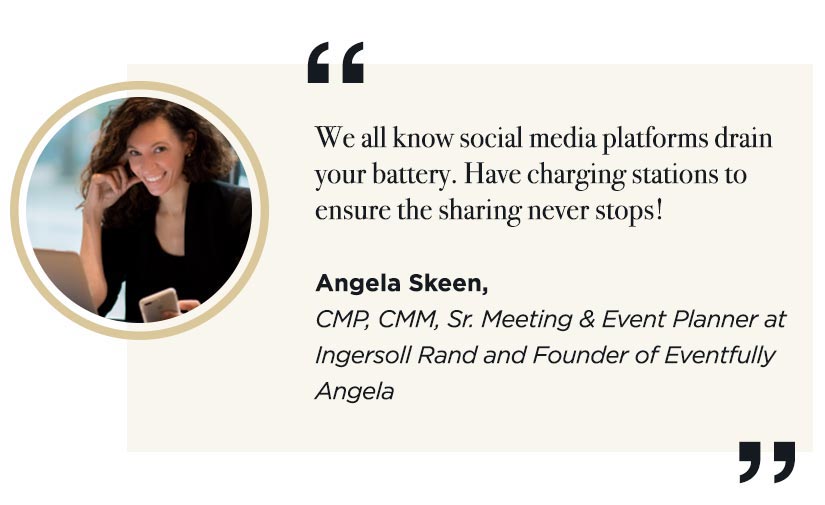
You want to encourage your attendees to post frequently to social media during events, as well as hyping up the event content via the official event channels. Here are some ideas to get the most out of your live event social media action.
-
Be Prepared
To build the excitement around your event and increase attendance at your next one, a bit of forward planning is needed to make the most of it. You might be busy running the event but ensure sure some team members have social media as their number one priority so you can make the most of real-time interaction and documenting opportunities – don’t let the moment pass you by.
Plan Ahead for Better Results:
- Allocate staff manage to social media throughout the event, including posting live content, responding to questions, retweeting/sharing/favoriting, customer service, and so forth.
- Define roles and responsibilities and lay down some guidelines in terms of style/tone of voice, how to respond to any negative posts, and who will cover different key parts of the event.
- Provide power, devices, WiFi/hard-wired internet and ensure they have access to any information which they may need to refer to or get asked.
- Create some templates (e.g. draft post content, templates to create quotes from speakers), have some collateral available (e.g. pictures of speakers, copies of presentation slides) and have lists of the social handles of all performers/speakers, sponsors, exhibitors and so forth.
- Get familiar with easy-to-use image creating software on your smartphone. That way you can transform speaker and audience quotes into image quotes as they happen.
-
Photo Booth and Image Snapping Opportunities
There are many app-based photo sharing tools which work on mobile devices and are portable. Some tools can create branded photos, a choice of background and effects and can automatically share to the event Facebook page or other social media networks and email a copy directly to the guest to create immediate content opportunities. Digital photo booths could connect to a large photo wall or straight onto your platforms showcasing snippets in real-time.
Encourage attendees to get involved by sharing their own photos and flood your hashtag with guests enjoying themselves. Think about your event and how to create photo-worthy moments.
Make Extra Impact:
- Go Quirky – opt for unique photo booths that stand out at the venue and draw attention. Inflatable or back to back booths, professional photographers, funky backdrops or green screens can create lasting impressions.
- Branding – consider organic ways to get your event name or hashtag onto the props, booth floor or walls, backdrop or décor that is in the shot. This way you are getting the maximum marketing benefit from each social share.
- Stand-out – oversized props, wow-factor elements, special opportunities to get involved in the event and moments that people want to show-off to their peers will go down well.
- Walking Props – Lacking space? Use frames, giant cut-outs, lookalikes/walking characters and other props that are mobile which can be interacted with or picked up by attendees at their leisure. This also means you have a diverse social media feed as the photos will generally have different backgrounds.
- Photo Feedback – Hang several pictures in your exit area or an area where people congregate, using emojis or characters and personas that fit your event theme. The pictures should be large enough to serve as a backdrop for a selfie and each of them should convey an emotion. For instance, you might have a picture of a smiling, indifferent and sad face. Ask guests to take a selfie with the one that best describes their experience of your event. Give them the hashtag and encourage them to share it on social media. You may not be able to run deep analytics on this but it’s a fun, engaging way to get visitors to participate and give feedback.
- Real-time Feedback
By listening closely to feedback during your event you can make changes on the fly. For example, if the event facilitator sees that there are a lot of questions and interest about a specific point a speaker made during their presentation, it could be worthwhile allocating some extra time to go further in depth. This helps connect with digital attendees and gives your audience and attendees what they are asking for.
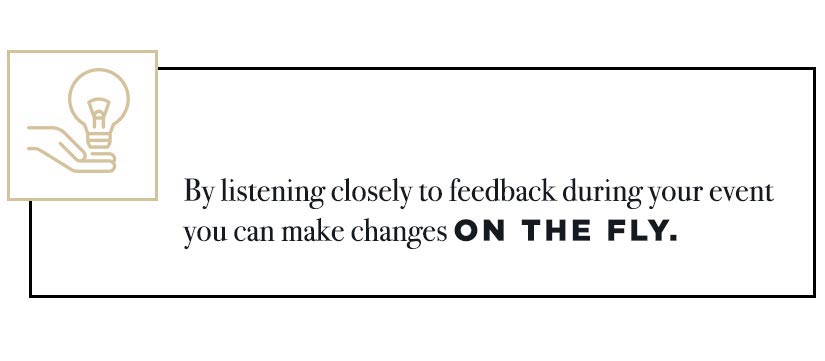
Tie Together Online and Offline Attendees:
- Personalization – Tag or mention attendees on social media where possible, for example tweeting out points or questions raised by attendees during the event. If you follow everyone who registers for your event and keep a list of attendee names and their social profiles it is easy to share (at least so long as the facilitator prompts them to give their name before asking their question!).
- Q&A – Live stream Q&A’s across your channels and use social media to integrate digital and physical attendees. Collect questions from your social media channels and ask them to the speaker to involve everyone.
- Customer Service – If someone tweets that the room is too warm or cold, this can be passed to the event manager rightaway to rectify it, and to thank the attendee for flagging it.
- Behind-the-Scenes
Give attendees a peek behind the curtain and show them the moments, hours or even days leading to your event. On the day you can still venture into the VIP or exclusive access areas, behind the scenes or give interesting perspectives on your social accounts.
Give a Glimpse of the Back Story:
- Interviews – Interview influencers, professionals and attendees about how the event is going, what we can expect to hear from them, any breaking news and their opinions on current topics to mix up your feed.
- Early Set-Up Videos – Seeing what it takes to create an event can be eye-opening for attendees who will probably appreciate your effort more after seeing the set-up process. Timelapse and progress reports can be powerful.
- Exclusive Access – Have a VIP lounge or backstage area? Give tours on your social media channels to create some real FOMO!
- Incentives to Share
Incentivize your followers to post more during the event. This generates an additional buzz which can transfer to the event itself while also blowing up your event social media.
Encourage Activity:
- Hashtag Competition – Followers can show love for images and media included in the event hashtag by liking or commenting. At the end of the event, award a prize to the account with the most interaction.
- Top Contributors – Create a top contributor list or leaderboard every day creating a competition among attendees to share the most.
- Deadline Rewards – During the event, offer rewards such as discount codes, tickets and prizes for interactions. For example, the first 10 attendees to share a post will receive an exclusive freebie, to claim attendees visit the registration booth with their event ticket and social account details.
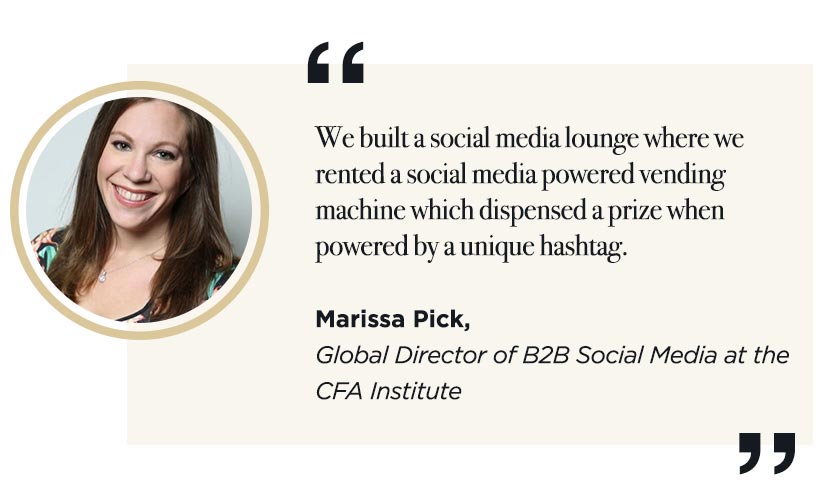
-
Make Social Central to Your Event
Make sure that social media activity is always front of mind to encourage maximum attendee social sharing at all of your events.
Give Regular Reminders to Be Social:
- Provide free WiFi and an easy to access log in process. Provide information around the venue and from the stage at key parts of the day.
- Create placards in public spaces reminding guests of the hashtag and how they can connect with you socially.
- Offer a networking or bloggers’ lounge that includes places to recharge and a quiet spot to write
- Use software that aggregates and shares live posts on a screen for all to see.
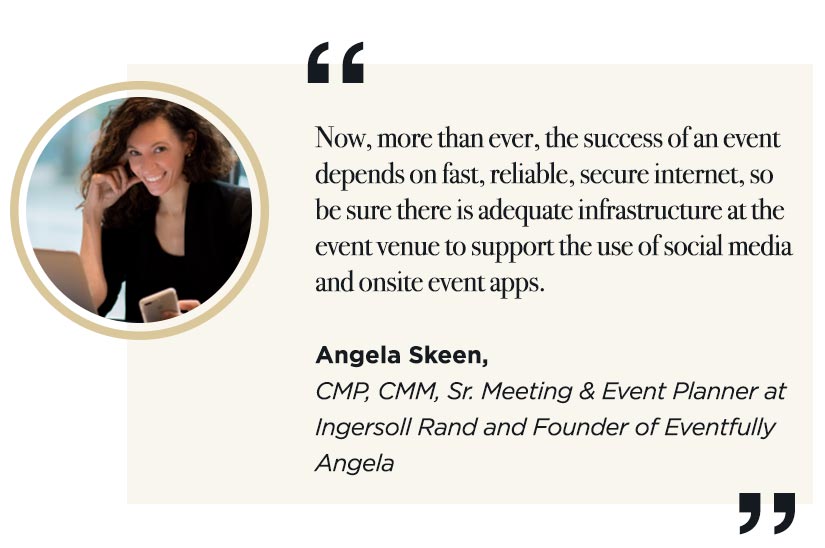
-
Walk the Walk
You can’t expect guests to be social if you aren’t. Every staff member in attendance should do their best to share content and share attendees’ posts. When you share their content, attendees feel special.
Lead by Example:
- Schedule content that isn’t time sensitive to publish automatically so that even if you are busy you can still be active.
- Focus on capturing and sharing the real-time happenings whenever you can. Your vantage point as an event planner is often exciting and different to what the public get to see.
- If you selectively share posts from attendees it helps them feel appreciated and encouraged to share more.
-
Share Quotes from Speakers
It’s a rare conference where attendees can be part of every session they want. Many overlap and they end up needing to choose one so instead, allow attendees to get value from more than one session at a time.
Make Extra Impact:
- Turn memorable moments from the event into graphics, images, gifs or memes to make your feed more interesting.
- Encourage speakers to pre-schedule and live share content to their social media channels.
- Links to presentation slides, free resources and extra content can be shared via social media.
- Make sure the event hashtag and speaker social media handles are on the slides.
After Your Event: 8 Ideas to Continue the Social Media High
Your event is finished, so you’re finished, right?
Wrong.
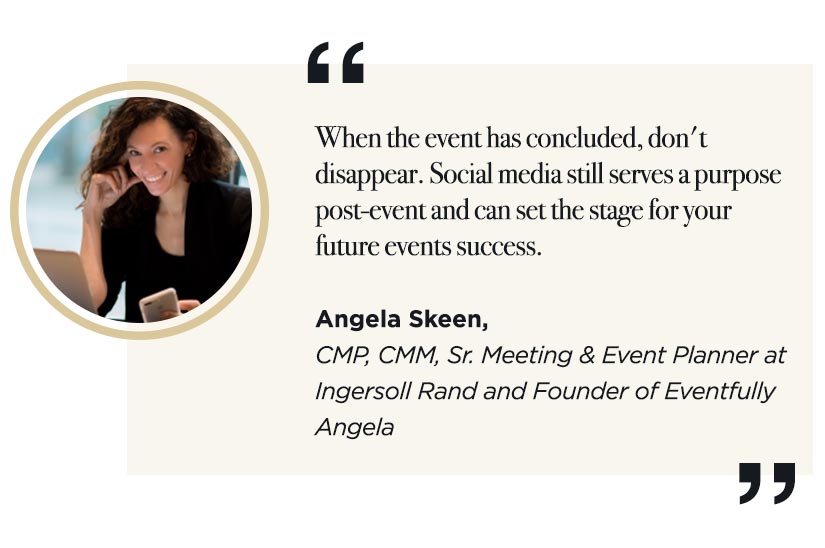
You will undoubtedly be relieved when you wrap up a successful event or conference but remember to keep the conversation going. If you suddenly stop using social media as soon as your event has finished, it will fizzle out and you’ll lose all the buzz you worked so hard to achieve.
Your event ending doesn’t mean the end of your relationship with attendees and it is crucial to stay active to foster loyalty and ongoing recognition. Utilizing social media by creating a consistently active and engaging channel is open to other opportunities such as your next ticket sales or marketing effort. If you stop or slow down it will be harder to gain the same momentum when you try to pick it back up again in the future.
Obviously, you won’t need to push as hard as before the event but it is important to find the balance, so here’s some ways you can spice up your social content post-event for a varied and engaging feed.
-
Polls
Quick polls on social media are a valuable and fun way to capture interest, even if they are not scientific. Everyone loves to give their opinion (it is the internet after all!) so frame questions in an opinion-worthy and fun way. This can not only help you determine ideas and popularity of your audience for the future but gets them engaging and therefore more likely to see your content going forward.
Find Out the Truth:
- Don’t be afraid to ask feedback or promote discussion whilst your event attendees are still on a high.
- Facebook and Twitter offer polls and Instagram allows you to add yes or no polls in the stories section.
-
Stay Present and Active
You have a whole wealth of information from your event, so make the most of it. Share the highlights and keep the conversations going long after the event while attendees are still hungry for more.
Stay Front of Mind (or Feeds):
- Ask open-ended questions or run a weekly Q&A so that you remain valuable on your channels.
- Create content around the conference, sharing everything from interesting facts about consumption to daily pictures.
- Keep the buzz going right into your announcements about next year’s event, which you will want to share quickly to get the date in people’s diaries.
-
Highlight Reel
If you have been live streaming or have video content from your event (if not, why not?) then you can create a short highlight reel of “best bits” to showcase. This gets attendees reminiscing and back to talking about the event.
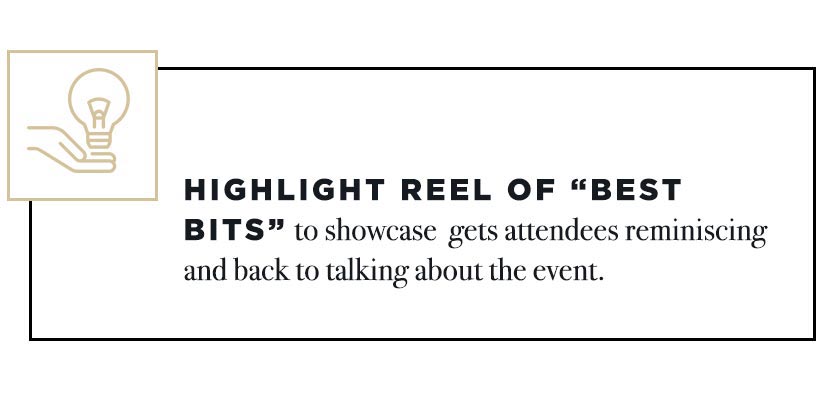
Capitalize on Video:
- If you have a lot of video, create a YouTube playlist or segments that follow the same themes to make searching easier.
- You could even request content from attendees on social media to submit their own videos and get a mention on your channels.
-
VIP, Influencer and Speaker Mentions
How can you encourage VIPs, speakers and influencers that attended your event to keep sharing? Tag them in the photo or post to encourage them to mention or share some of your content from the day. It expands your reach to two audiences while also introducing you to others who may have missed you the first time.
Share Irresistible Content Influencers Will Want to Share:
- Professional event pictures, snippets, quotes, highlights and praise can all be useful to capture attention and encourage interaction.
- Content such as this can also be appealing to their superfans to reshare.
-
#TBT
The ultimate post-event tag on social media (Throwback Thursday) which means you can post or showcase previous content from your event. If you can, tag and thank the included attendees, staff, suppliers etc. in your picture to recollect and bring you back to the forefront of their minds.
Use the Power of Nostalgia:
- Choose the pictures that best communicate the key aspects and appeal of your event.
- Instagram Stories now allows content older than 24 hours to be included.
- Check out other hashtags you should be engaging with on social media, relevant to your audience.
-
Virtual Sessions
You can capitalize on those who have missed your conference or keynote by offering virtual access to sessions after the event is over. You may decided to make this freely available or charge a fee for access.
Enable On-demand Catch-up:
- Check with your speakers and write it into their contract if you want to broadcast their presentation in any way, shape or form.
- Whether you decide to charge or give recordings away as a benefit of membership, you should release sound bites to whet your audience’s appetite and get them interested in the sessions.
-
Attendee-only Rewards
Extend the event excitement by offering rewards just for those who were there, to make them feel special and to let them know their loyalty is valued and you want it to continue.
Reward Past Attendees:
- If new products were launched at your event, offer exclusive discount codes to attendees only, available for a set period after the event.
- Offer a loyalty ticket rate available for attendees to sign up for next year’s event right away at a lower cost. Although the full line up details haven’t been released some attendees will be keen to snap up a ticket at a bargain rate and it means you have some revenue from early ticket sales.
-
Be Grateful
Spend some time going through your event hashtag, commenting and interacting with those who attended or got involved to make sure you didn’t miss anyone and to reshare the best content. Ultimately, you’ve had a great event and built excitement around attendance and activities. Your attendees are returning home happy and inspired. Jump on that euphoria through social media and use it to your advantage.
- Say thank you, even to attendees who are late posting. Make sure you audience know that it is worth keeping sharing and you will notice and engage.
- Recognize and search for blog posts about the event and share on your channels as a thank you to the blogger for spending the time to write about your event.
- Keep browsing on a daily basis for a good few weeks after the event and ask permission to share, retweet or use their images on your blog, website or as testimonials.
4 Steps To Keep Your Cool and Navigate an Event Social Media Crisis
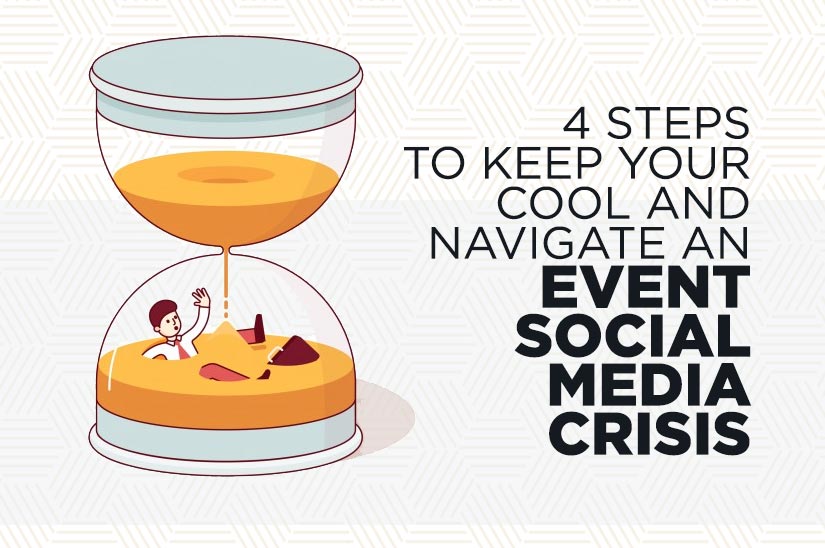
Welcome to every event professional’s worst nightmare.
You focus on all the right stuff. The music, lighting, content, and all the logistics that must be handled expertly in order to make an event come together. But what happens when your keynote speaker gets busted for drugs and it’s splashed all over the media the day before your event? Or someone tweets to your conference hashtag about an incident of Zika being reported two blocks from your event site? Whether you are dealing with a natural disaster, industry shakeup, pornographic tweetstorm, or human tragedy you need to be ready to respond quickly.
To be prepared for negativity and crisis, there are a few things you should be doing in advance of your event. Consider potential scenarios. Ask your team questions and identify the best solutions. Having a clear idea in advance of a challenge will lead to a better outcome.
Some questions that you should consider, include:
- Who is responsible for making the communications decisions on site?
- Who will implement the updates?
- Which communication channels will you use?
- What is your Plan B? What do you do if key players are away?
Things escalate very quickly on social media. When crisis hits how can you best navigate the tone and direction of your social media communications for your audience? Here are four key steps that will get you through the digital hard times.
-
Validate the Problem
First you will need to make sure that the situation at hand is truly a crisis and to rate the severity. If serious, it is time to gather your Crisis Response Team, an outside crisis expert, and your legal team to discuss next steps and a potential response.
-
Collect All The Facts
Be sure that everyone handling the emergency is present and fully understands what’s happening because you don’t want miscommunication on your channels.
Ask:
- What happened?
- Why?
- Who was involved?
- What happens next?
- What will we say?
Once the problem is validated and the facts collected, it’s important to consider the options available to your team.
-
Empower Your Team
Attendees aren’t the only ones who have social media accounts. Once you have a plan in place, it does no good unless all members of your team understand it and know what’s expected of them. Your staff need to be prepared before a crisis strikes, so that just like you, they understand what to do and will be empowered to help your cause.
-
Communicate Quickly (and Accurately) With Your Audience
The most important thing you can do is to respond calmly and quickly with the facts. The first hours are crucial because people are waiting for a response from your organization. The longer you wait, the worse it is and the higher the likelihood of your audience making inaccurate guesses based on hearsay.
Tell your audience how you are addressing the problem as the crisis is happening. Without this there will be rumor and speculation, which can make a small crisis turn into a major one.
Social media has changed the timeline of when followers expect a response. It has given them a lot of power to speak directly to the media and each other so a swift response should always be the objective.
While the dangers in managing a social media crisis are clear, every problem brings with it an opportunity and some organizations may find a chance to take a negative experience and spin it into something more inspirational.
10 Trends in Social Media for Events
Should trends affect your social media strategy? Absolutely. When it comes to social media, there is no time to discount tools or tactics as hype. Things are evolving so quickly that regardless of whether a trend catches on or not, all social networks will quickly adapt and roll out changes. Your learning curve should be constant.
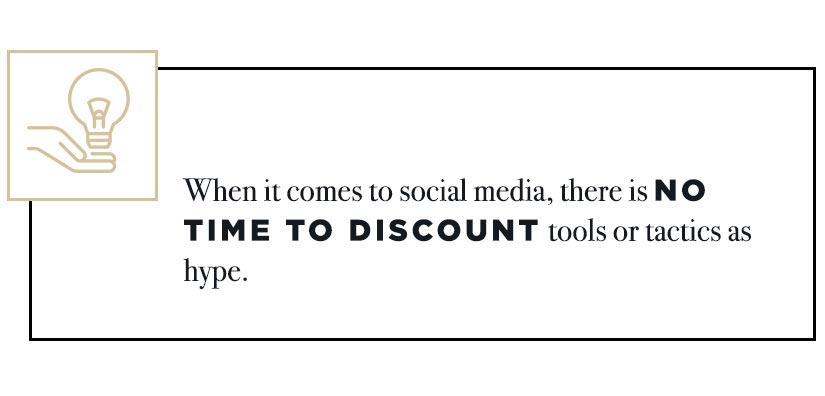
Yet, there is so much going on!
This is why we will focus your attention on 10 trends that really matter. We are narrowing down the recent changes of major social networks to the most relevant to sell events using social media.
1. Maximizing Offline Opportunities
Times are mature enough to truly combine the power of online and offline. Experiential marketing when combined with a strong social media campaign offers maximum marketing reach. It isn’t enough just to run a powerful event or a great social media campaign, for maximum results the two need to work hand in hand. This doesn’t just relate to big budget events either, although of course, it helps!
Do This Now:
- Make sure your event offers clear social media opportunities. Don’t expect attendees to share, interact and create content without any prompts. So let yourself go with offline props, photobooth areas, unexpected and serendipitous picture moments.
- Can you identify moments of your event that will be popular with social media? Then make sure your social media team is ready with specific hashtags or creates pre-buzz online before the actual moment.
- Give access to specific areas of your event to those more active on social. It will draw more people to use social media and engage with your hashtag.
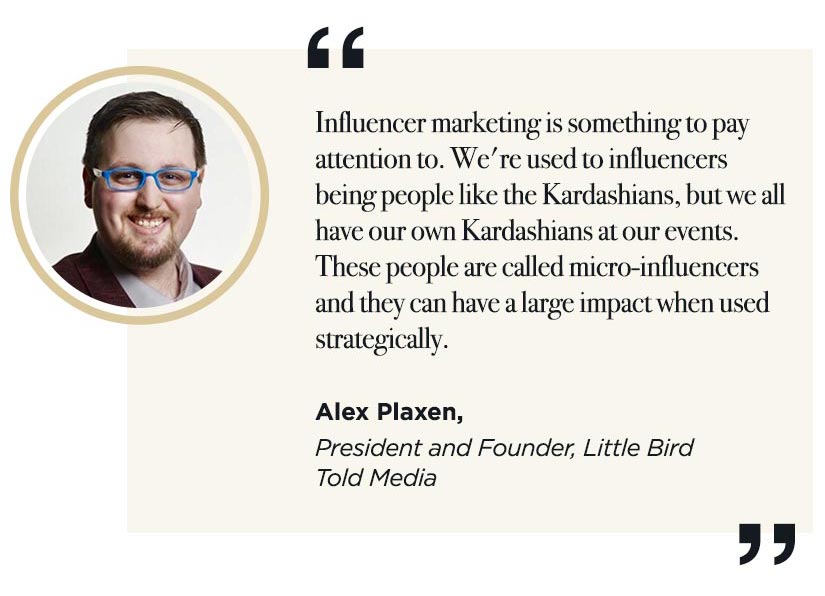
2. Power to Powerful Brands
Don’t think that just because your event happens over one day, two days or a week, you are discounted from creating a proper brand on your social channels. Too often events have had an amateurish, sluggish and not up to standard representation of their brand on social channels. Having a strong brand on social media reflects the image of the event and the level of attention to details that attendees will face at the actual event.
Master Your Brand on Social Media:
- Make sure you have a basic level of identity on social media. Use the same color palettes, filters, logo and pictures. While it is tempting to be taken by the moment, you are always representing a brand, not yourself. Spontaneity needs to happen within the image of your event.
- Set up a clear tone of voice for your team handling social media. What is acceptable? How should they talk to attendees or prospective attendees?
- Invest in social networks that can really add value to your brand and truly reflect your audience. Don’t chase buzzworthy social platforms that are not in line with your brand proposition.
3. True Influencers Powers
As in 2009 for ‘social media experts’, there is a bunch of unemployed individuals who don’t have a voice or a channel calling themselves influencers. Having influencers for your event is probably the strongest social media tactic you will have in 2018. Influencer social media marketing is key but you have to be careful. Having an influencer strategy is key for events in 2018. Mastering how to use them in performance (speaking) slots is one example of how events have the power to truly take advantage of the influencer wave.
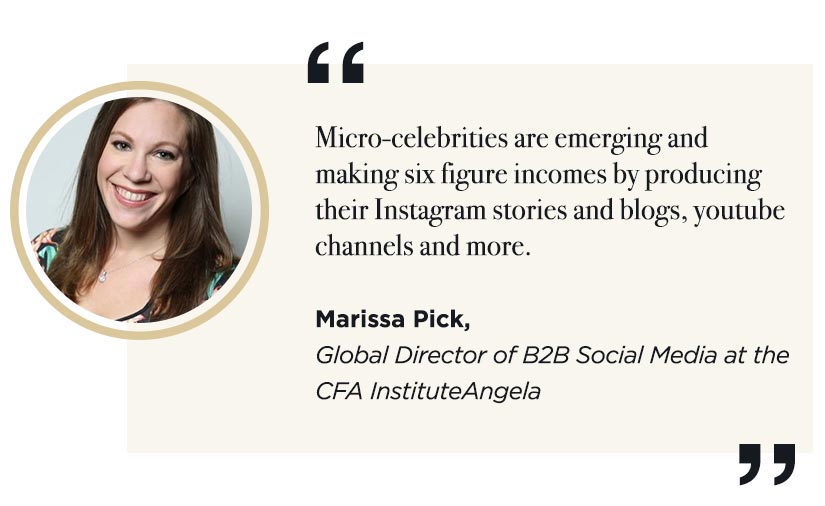
How To Master Influence:
- Look in depth at numbers, type of content, channel presence and depth of engagement of your selected influencer.
- Analyze if they have participated in any other event and in what capacity. Do their updates gain traction? Are they able to drive ticket interest? Can you see proof?
- Use platforms that allow influencer marketing tracking. Have tools in place to measure what the impact of your chosen influencers is to your event.
4. Slow Selling
The public is immune to advertising and will tune out or bypass sales information that doesn’t immediately interest them. This is even more true on social media. Selling switches people off, blasting out sales and marketing messages is not therefore an effective marketing strategy, we need to be more savvy for 2018. Gradual introductions and relationship building, without the hard sell, will yield higher overall conversions. There is no quick-win situation.
Be a Social Selling Ninja:
- Set up a system of analytics to clearly identify how content on social media converts into sales. Sometimes it will take 20 touch points before you actually sell a ticket. Do you have the stamina? But, most of all, do you have the tools to analyze the path to conversion?
- A good strategy is to draw people in and get them invested first, before any sales call to actions are revealed.
- Build value with content, create FOMO with content, ignite excitement, exclusivity, scarcity. This is what social media is awesome for. Use videos from previous events, get your performers involved with updates and short intro videos. Talk about what your programme will cover.
5. Stories Dominate
The Snapchat and Instagram battle continues, continuing to push a quick succession of big developments in features on both platforms which is exciting for users. This pace of innovation doesn’t look like it will subside in 2018, so event planners need to keep an eye in terms of the most recent updates that may be of interest in terms of event marketing. The clear winner here is stories. A new format both social networks master well. This is what you need to tell your team to look into for 2018 – provided you have an audience match of course!
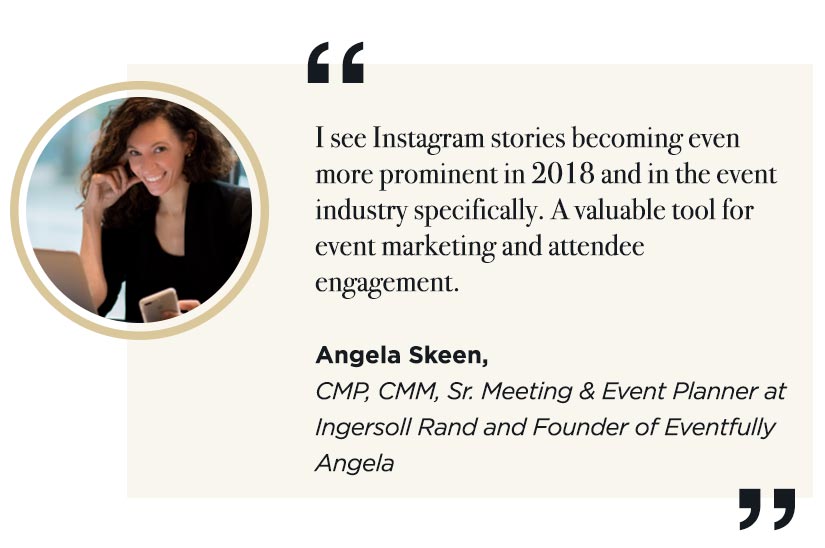
Truly Grasp the Power of Stories:
- Instagram users can search for a location or hashtag, and see a Story compiled from posts from other users that include that location sticker, hashtag sticker, or hashtag in the caption. Location Stories from nearby places will also appear featured in the Explore tab.
- Stories now allows photos and videos more than 24-hours old to be added as a flashback, automatically adding a timestamp. This could be handy for throwbacks to past event highlights and marketing reminders.
- Instagram Stories’ polling feature collects votes in real time and allows users to view the results. Instagram comment controls have just been improved for better moderation. Quirky tricks such as superzoom can be used in interesting ways at events.
- Snapchat Custom Stories make it easier for groups of people to share their experience together and up to three custom Stories can be created at a time and shared with only relevant people. For your event, you could create a Custom Story and allow everyone in attendance to add their content to your timeline.
- The controversial Snap Map can show Snapchat users locations and display it for their friends. What is worth event marketers taking note of though is the potential to browse posts from strangers who are sharing publicly around the globe. On the Snap Map snaps from that area can be viewed. The red on the heatmap shows areas of high activity and Snapchat are keen to highlight events, celebrations and breaking news. Stories show up at special locations and events and can be viewed by tapping the circular thumbnails.
6. Newsjacking
Newsjacking refers to the ability of interjecting breaking news to capture the interest of social media users to the topic. It is a very delicate matter. It has lead in the past to the biggest social media blunders to memory, specially if left in the hands of inexperienced social media users.
How to Become a Newsjacker:
- Comment only if there is a line of connection between the news and the content of your event. Being gratuitous won’t help you, it will make you look silly.
- Provide a perspective on the news, create some valuable content around it, make it valuable for readers and refrain to pitch yourself. Just make sure to have clear call to action on the content platform you use to discuss the news, don’t use content to sell.
- Use your speakers to comment on news. Get a few quotes, quickly, use blogging to newsjack and social networks to amplify.
7. Invest in Video
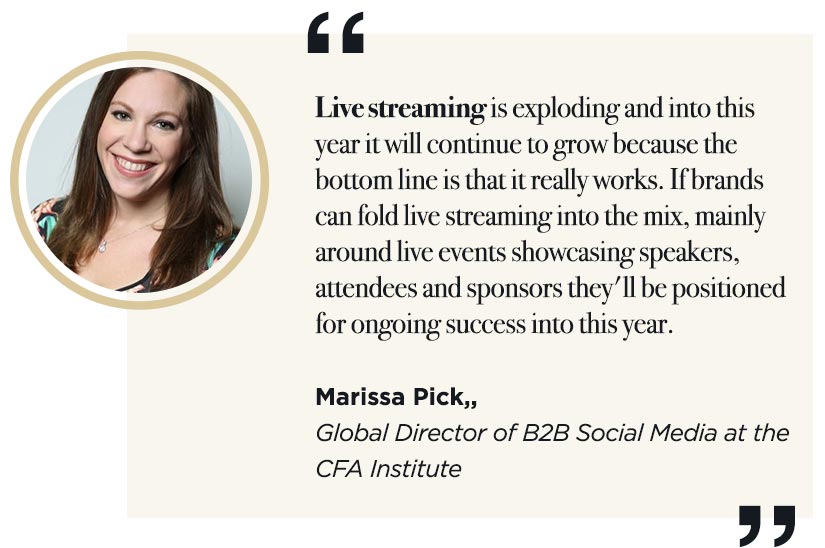
Video is taking over the internet. Mostly because major social networks want users to create video. This means your videos and your live video, will inevitably be favored on most social networks offering more tangible organic opportunities.
A solid event has a solid video strategy at the event. This will become some of the most important marketing material you have for the next year. Think how you can use video and live video at your event to sell tickets next year.
How to Make the Most of Video:
- Invest in Facebook Live. Facebook has cut all the ties with your fans on the platform. There is very little chance to get organic engagement with your fans unless you pay for Facebook Ads. This is not true for video and Facebook Live. Definitively worth the investment.
- Sync multiple live-streaming platforms at the same time. Invest in tools that allow you to stream on Periscope, YouTube, Facebook and Instagram. Maximize your live presence by having one stream for all of them.
- Step up your testimonials game. It’s a crime to not capture testimonials from attendees and stakeholders while they are at the height of excitement around your event.
8. Social Media Takeovers
Can you give up the control of your brand to someone else? If there is an audience fit, the answer is you should! The immediate benefits are to have a relevant audience of followers, ready to engage with your brand and potentially attend your event. The same rules of influencer selection apply to social media takeovers.
How to Craft the Perfect Social Media Takeover:
- Choose well. Consider whether there is an audience fit with the followers of the selected influencer. Also, consider their tone of voice and how it aligns to your brand.
- Leverage speakers and partners. Speakers and performers are the immediate choice for takeovers but what about sponsors? As content marketing is evolving, brands are developing strong voices you want to listen to. Get them involved if they have a strong social presence and enjoy the benefit of a large audience.
- Combine takeovers with giveaways. This is a great reason to move over social followers. Many venues are doing takeovers successfully with influential bloggers and giving away prizes (event tickets being the most obvious ones for you) to those that engage with the takeover.
9. Understand the Power of FOMO
Let’s be honest, social media has been just a great customer service tool until a few years ago. Very few were able to sell through it. Too much time needed, too many resources, poor ROI. Until Fear Of Missing Out materialized. Many years ago event planners dreaded social media for the risk of losing attendance at events and people choosing to follow via the social networks instead. The opposite is actually happening. The use of social media before, during, and after events is creating a sense of desperation in audiences watching online but unable to attend. We finally found a direct cause that can convert to ticket sales on social media
How to Create FOMO on Social:
- Get attendees to share the fact they are attending on social media. Not just by having a share link on registration. Do more! Give them incentives, offer rewards for sharing, prepopulate tweets, Facebook updates. Creatively get them to share their excitement, this is the first element to create FOMO.
- Most of the FOMO opportunities will be created during the event, you need to get attendees to sell tickets for next year. Do you have registration for next year open during this year event? Capitalize on the frustration not to attend. Get online lurkers to commit to buy for next year and resolve their frustration.
- Video is your ally. Use video wisely to show what really happened when everybody was adding a story to Instagram. Combine public updates with your event video and show how your event creates that need to be there.
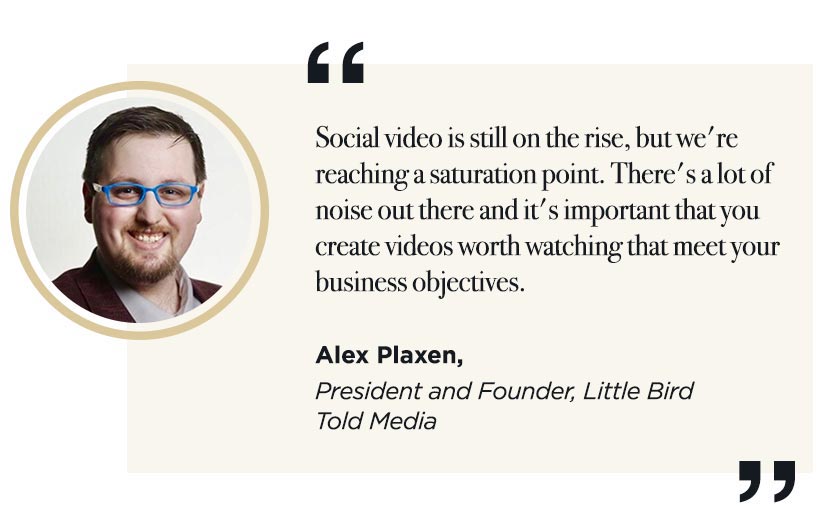
10. The Death of Real Time
Don’t get us wrong, real time updates are still relevant especially in terms of Stories. Yet major social networks that traditionally have a marketing element, such as Twitter, Facebook or LinkedIn, are discouraging users from constantly updating their streams. They are doing so by highlighting only those updates that got most engagement to the top of the streams. Therefore instead of quantity, you should consider quality in terms of social media. Pulling out 100 tweets or blog posts is not going to serve much. And yes, if you are asking if the same concept applies to SEO, it is most definitely the case.
How to Master Algorithms:
- Prefer one daily update that has value over a constant flows of updates in the lead up to your event.
- Repurpose the content that is known to perform best on social networks. It is most likely that a wide base of your audience has missed it. Get them to see it.
- Variate messaging and see what works. Run some A/B tests on different social networks. Occasionally use social advertising to give initial speed to your update.
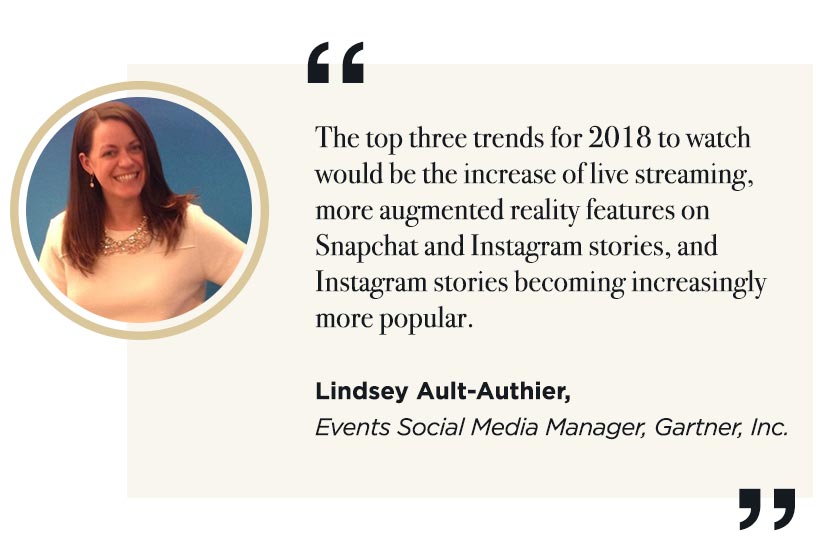
Bonus Video: Event Promotion: 6 Advanced Tactics To Promote Events with Social Media
This video is brought to you by QuickMobile by Cvent, improve engagement at events with social media.
If you can’t see the video, Click here.
In Conclusion
Social media is an essential part of modern events today and offers lots of benefits and opportunities to develop long term relationships and grow the communities and buzz surrounding your event. From customer service, updates and feedback, through to selling more tickets and ensuring greater FOMO, this guide is aimed at helping you nail your social media strategy.
Social media moves quickly and we are committed to continually updating this page with the latest tips, strategy, guidance and thinking, which will help you to offer a more robust social media strategy and output.
Now onto you:
- Do you have a tip to make this page better? Send an email to [email protected]
- Do you have more tips to add? Comment below
- Do you have a colleague who may benefit from reading this page? Share it with them
